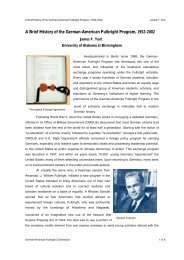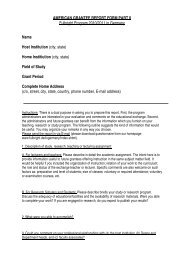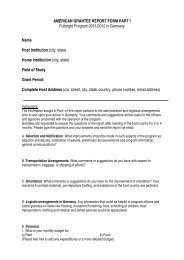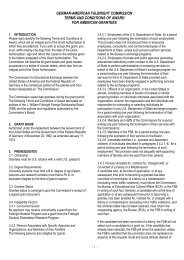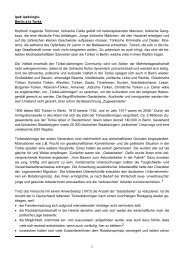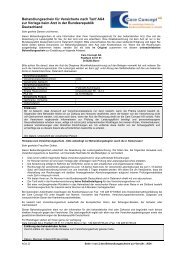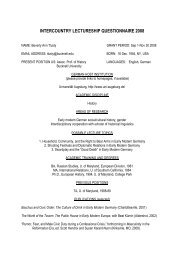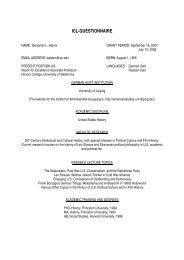Access and choice – competition under the roof of solidarity in ...
Access and choice – competition under the roof of solidarity in ...
Access and choice – competition under the roof of solidarity in ...
Create successful ePaper yourself
Turn your PDF publications into a flip-book with our unique Google optimized e-Paper software.
Health Economics, Policy <strong>and</strong> Law (2010), 5, 31<strong>–</strong>52<br />
& Cambridge University Press 2009 doi:10.1017/S1744133109990144<br />
<strong>Access</strong> <strong>and</strong> <strong>choice</strong> -- <strong>competition</strong> <strong>under</strong> <strong>the</strong><br />
<strong>ro<strong>of</strong></strong> <strong>of</strong> <strong>solidarity</strong> <strong>in</strong> German health care: an<br />
analysis <strong>of</strong> health policy reforms s<strong>in</strong>ce 2004<br />
MELANIE LISAC<br />
Project Manager, International Network Health Policy & Reform, Bertelsmann Stiftung, Gütersloh, Germany<br />
LUTZ REIMERS<br />
Department <strong>of</strong> Public F<strong>in</strong>ance <strong>and</strong> Health Economics, Technische Universität Berl<strong>in</strong>, Germany<br />
KLAUS-DIRK HENKE*<br />
Pr<strong>of</strong>essor <strong>of</strong> Public F<strong>in</strong>ance <strong>and</strong> Health Economics, Technische Universität Berl<strong>in</strong>, Germany<br />
SOPHIA SCHLETTE*<br />
Senior Expert Health Policy, Bertelsmann Stiflung, Gütersloh, Germany, currently on a sabbatical as Senior<br />
International Adviser, Kaiser Permanente Institute for Health Policy, Oakl<strong>and</strong>, CA, USA<br />
Abstract: This paper analyses <strong>the</strong> <strong>in</strong>fluence <strong>of</strong> recent German health care<br />
reforms, <strong>the</strong> Statutory Health Insurance Modernization Act 2004 <strong>and</strong> <strong>the</strong><br />
Statutory Health Insurance Competition Streng<strong>the</strong>n<strong>in</strong>g Act 2007, on different<br />
dimensions <strong>of</strong> access <strong>and</strong> <strong>choice</strong>. More specifically, we look at <strong>and</strong> discuss <strong>the</strong><br />
effects <strong>of</strong> <strong>the</strong>se policies on <strong>the</strong> availability, reachability <strong>and</strong> affordability <strong>of</strong><br />
health care as well as on <strong>the</strong>ir impact on consumers’ <strong>choice</strong> <strong>of</strong> <strong>in</strong>surers <strong>and</strong><br />
providers. Generally, patients <strong>in</strong> Germany enjoy a high degree <strong>of</strong> free access<br />
<strong>and</strong> a lot <strong>of</strong> freedom to choose, partly lead<strong>in</strong>g to over- <strong>and</strong> misuse <strong>of</strong> health<br />
services. Concern<strong>in</strong>g <strong>choice</strong> <strong>of</strong> <strong>in</strong>surers, one result <strong>of</strong> our analysis is that <strong>in</strong> <strong>the</strong><br />
statutory health <strong>in</strong>surance system, <strong>the</strong> <strong>in</strong>troduction <strong>of</strong> a greater variety <strong>of</strong><br />
benefit packages will develop <strong>in</strong>to an additional parameter <strong>of</strong> <strong>choice</strong>. In<br />
contrast to that, <strong>in</strong>surees more <strong>and</strong> more accept certa<strong>in</strong> restrictions <strong>of</strong> <strong>choice</strong><br />
<strong>and</strong> direct access to providers by enroll<strong>in</strong>g <strong>in</strong>to new forms <strong>of</strong> care (such as<br />
gatekeep<strong>in</strong>g-, disease management- <strong>and</strong> <strong>in</strong>tegrated care programmes).<br />
However, <strong>the</strong>y might benefit from better quality <strong>of</strong> care <strong>and</strong> more options for<br />
products <strong>and</strong> services that best fit <strong>the</strong>ir needs.<br />
1. Introduction<br />
Germans enjoy a high degree <strong>of</strong> free access to health care <strong>and</strong> <strong>of</strong> <strong>choice</strong> <strong>of</strong> both<br />
providers <strong>and</strong> health care <strong>in</strong>surance. Compared to o<strong>the</strong>r <strong>in</strong>dustrialised countries,<br />
<strong>the</strong> health care <strong>in</strong>frastructure is well developed <strong>and</strong> with<strong>in</strong> easy reach; numbers<br />
*Correspondence to: Sophia Schlette, Bertelsmann Stiftung, Gütersloh, Germany. Email: sophia.schlette@<br />
bertelsmann-stiftung.de, <strong>and</strong> *Klaus-Dirk Henke, TU Berl<strong>in</strong>, at KHenke@f<strong>in</strong>ance.ww.tu-berl<strong>in</strong>.de<br />
31
32 M E L A N I E L I S A C E T A L .<br />
<strong>of</strong> physicians <strong>and</strong> nurses per population lie above OECD (Organisation for<br />
Economic Co-operation <strong>and</strong> Development) average. Ra<strong>the</strong>r than <strong>under</strong>use, <strong>the</strong><br />
German system is characterised by over- <strong>and</strong> misuse <strong>of</strong> health care services<br />
(Advisory Council on <strong>the</strong> Assessment <strong>of</strong> Developments <strong>in</strong> <strong>the</strong> Health Care<br />
System, 2001). Therefore, policy makers have recently <strong>in</strong>troduced measures to<br />
<strong>in</strong>duce more rational utilisation <strong>of</strong> services <strong>and</strong> to limit free <strong>choice</strong> <strong>of</strong> providers<br />
for patients, which st<strong>and</strong>s <strong>in</strong> contrast to developments <strong>in</strong> <strong>the</strong> USA, <strong>the</strong> UK <strong>and</strong><br />
some o<strong>the</strong>r countries, where patient <strong>choice</strong> has been <strong>in</strong>creased.<br />
The Statutory Health Insurance Modernization Act <strong>of</strong> 2004 (2004 reform) <strong>and</strong><br />
<strong>the</strong> Statutory Health Insurance Competition Streng<strong>the</strong>n<strong>in</strong>g Act <strong>of</strong> 2007 (SHI-<br />
CSA) constitute turn<strong>in</strong>g po<strong>in</strong>ts <strong>in</strong> this regard (Federal M<strong>in</strong>istry <strong>of</strong> Health, 2003,<br />
2007a). The 2004 reform <strong>in</strong>troduced a quarterly co-payment for first visits to an<br />
outpatient provider <strong>and</strong> for visits to any o<strong>the</strong>r physician dur<strong>in</strong>g <strong>the</strong> same quarter<br />
without referral. 1 Both acts promote care coord<strong>in</strong>ation by <strong>in</strong>troduc<strong>in</strong>g voluntary<br />
restrictions on patients’ <strong>choice</strong> <strong>of</strong> provider <strong>and</strong> elements <strong>of</strong> managed care.<br />
At <strong>the</strong> same time, <strong>the</strong> 2004 <strong>and</strong> 2007 reforms aim to <strong>in</strong>crease <strong>competition</strong><br />
among health care providers <strong>and</strong> health <strong>in</strong>surers by giv<strong>in</strong>g patients more <strong>choice</strong><br />
between health <strong>in</strong>surers <strong>and</strong> benefit packages. The objective <strong>of</strong> <strong>the</strong>se measures is<br />
to improve efficiency, quality <strong>and</strong> patient responsiveness.<br />
While <strong>the</strong> focus <strong>of</strong> this paper is on <strong>the</strong> aforementioned reform measures, we<br />
also look <strong>in</strong>to o<strong>the</strong>r measures <strong>of</strong> <strong>the</strong> 2004 <strong>and</strong> 2007 reforms that have an impact<br />
on access <strong>and</strong> <strong>choice</strong>, for example, measures that aim to mitigate negative effects<br />
<strong>of</strong> <strong>the</strong> loom<strong>in</strong>g shortage <strong>of</strong> health care providers <strong>in</strong> some German regions, <strong>and</strong><br />
<strong>the</strong> extension <strong>of</strong> <strong>the</strong> benefit basket to <strong>in</strong>clude additional preventive, rehabilitative<br />
<strong>and</strong> palliative care services.<br />
The paper is organised as follows. In Section 2, we outl<strong>in</strong>e <strong>the</strong> method <strong>and</strong> our<br />
analytical framework. In Section 3, we describe <strong>the</strong> measures relevant to access<br />
<strong>and</strong> <strong>choice</strong> <strong>in</strong>troduced with <strong>the</strong> 2004 <strong>and</strong> 2007 reforms, <strong>and</strong> we assess <strong>the</strong>ir<br />
impact on <strong>the</strong> different dimensions <strong>of</strong> access <strong>and</strong> <strong>choice</strong>. In <strong>the</strong> f<strong>in</strong>al section, we<br />
discuss <strong>the</strong> implications <strong>of</strong> our f<strong>in</strong>d<strong>in</strong>gs for policy makers <strong>and</strong> researchers.<br />
2. Method <strong>and</strong> analytical framework<br />
2.1 Method<br />
We review <strong>the</strong> content <strong>and</strong> objectives <strong>of</strong> two major health care reforms <strong>in</strong><br />
Germany: <strong>the</strong> Statutory Health Insurance Modernization Act <strong>of</strong> 2004 <strong>and</strong> <strong>the</strong><br />
Statutory Health Insurance Competition Streng<strong>the</strong>n<strong>in</strong>g Act <strong>of</strong> 2007. With<strong>in</strong> <strong>the</strong><br />
analytical framework outl<strong>in</strong>ed below, we assess <strong>the</strong> impact <strong>of</strong> <strong>the</strong>se reforms on<br />
different dimensions <strong>of</strong> access (affordability, availability, reachability) <strong>and</strong><br />
<strong>choice</strong> (patients’ <strong>choice</strong> <strong>of</strong> health <strong>in</strong>surance system, health <strong>in</strong>surers, benefit<br />
1 Cost-shar<strong>in</strong>g <strong>in</strong> <strong>the</strong> form <strong>of</strong> co-payments for pharmaceuticals, medical aids, transport costs <strong>and</strong> so<br />
on, already existed before 2004.
packages, providers). To do so, we use a variety <strong>of</strong> literature sources, <strong>in</strong>clud<strong>in</strong>g<br />
academic literature, policy documents <strong>and</strong> results from population surveys, such as<br />
<strong>the</strong> German Socio-Economic Panel Study (see Grabka et al., 2006; Schreyögg <strong>and</strong><br />
Grabka, 2008) <strong>and</strong> representative surveys <strong>of</strong> statutory health <strong>in</strong>surance (SHI)<br />
<strong>and</strong> private health <strong>in</strong>surance (PHI) <strong>in</strong>surees carried out by <strong>the</strong> research <strong>in</strong>stitutes<br />
<strong>of</strong> local sickness funds, Wissenschaftliches Institut der Ortskrankenkassen, WIdO<br />
(see Zok, 2004, 2005), <strong>the</strong> Central Research Institute for Ambulatory Health Care<br />
<strong>in</strong> Germany (see Koch <strong>and</strong> Brenner, 2005) <strong>and</strong> <strong>the</strong> Healthcare Monitor <strong>of</strong> <strong>the</strong><br />
Bertelsmann Stiftung, a German non-pr<strong>of</strong>it foundation (see Gebhardt, 2005).<br />
2.2 Analytical framework<br />
<strong>Access</strong> <strong>and</strong> <strong>choice</strong> <strong>–</strong> <strong>competition</strong> <strong>in</strong> German health care 33<br />
Def<strong>in</strong>itions <strong>of</strong> access <strong>in</strong> <strong>the</strong> health economic literature emphasise different aspects<br />
<strong>of</strong> access. A common def<strong>in</strong>ition sees access as a m<strong>in</strong>imum set <strong>of</strong> benefits that<br />
ensures that no citizen falls beneath a particular level <strong>of</strong> care. Ano<strong>the</strong>r common<br />
def<strong>in</strong>ition sees access guaranteed when <strong>the</strong> same level or quality <strong>of</strong> health care is<br />
equally accessible to all, regardless <strong>of</strong> social status, residence <strong>and</strong> <strong>in</strong>come (Wörz<br />
et al., 2006). Roberts et al. (2004) dist<strong>in</strong>guish between physical availability<br />
measured by <strong>in</strong>puts (such as capital <strong>in</strong>vestments, human resources, knowledge) <strong>in</strong><br />
relation to <strong>the</strong> population <strong>and</strong> <strong>the</strong> effective availability <strong>of</strong> care (what services are<br />
<strong>of</strong>fered at what locations <strong>and</strong> at what prices?). Cost, travel time, poor services<br />
<strong>and</strong> so forth are possible barriers to access. Wagstaff <strong>and</strong> van Doorslaer (2000)<br />
circumscribe <strong>the</strong> term by say<strong>in</strong>g that access is what is usually meant by ‘receipt <strong>of</strong><br />
treatment’. An early def<strong>in</strong>ition by Le Gr<strong>and</strong> (1982) th<strong>in</strong>ks <strong>of</strong> access <strong>in</strong> terms <strong>of</strong> <strong>the</strong><br />
money <strong>and</strong> time cost that people <strong>in</strong>cur <strong>in</strong> obta<strong>in</strong><strong>in</strong>g health care, thus neglect<strong>in</strong>g<br />
<strong>the</strong> role <strong>of</strong> <strong>in</strong>come. Olson <strong>and</strong> Rodgers (1991) def<strong>in</strong>e access as <strong>the</strong> maximum<br />
atta<strong>in</strong>able level <strong>of</strong> consumption <strong>of</strong> medical care, given <strong>the</strong> <strong>in</strong>dividual’s <strong>in</strong>come,<br />
<strong>and</strong> <strong>the</strong> time <strong>and</strong> money prices associated with consumption.<br />
For <strong>the</strong> purpose <strong>of</strong> this paper, we comb<strong>in</strong>e some <strong>of</strong> <strong>the</strong> above <strong>and</strong> refer to<br />
three different dimensions <strong>of</strong> access. First, availability <strong>of</strong> care (<strong>in</strong>clud<strong>in</strong>g capacity<br />
<strong>of</strong> <strong>the</strong> system such as number <strong>of</strong> providers), second, reachability (geographical<br />
distribution <strong>of</strong> providers) <strong>and</strong> third, affordability (<strong>in</strong>clud<strong>in</strong>g f<strong>in</strong>anc<strong>in</strong>g<br />
<strong>and</strong> <strong>in</strong>surance arrangements <strong>and</strong> <strong>the</strong> reimbursability <strong>of</strong> services). In general,<br />
<strong>the</strong>re are few <strong>in</strong>frastructural or geographic barriers to access health care <strong>in</strong><br />
Germany <strong>and</strong> most <strong>of</strong> <strong>the</strong> debate on access <strong>in</strong> Germany focuses on affordability<br />
as <strong>the</strong> paramount dimension <strong>of</strong> access. This focus on affordability can partly be<br />
derived from <strong>the</strong> outst<strong>and</strong><strong>in</strong>g role that <strong>the</strong> notion <strong>of</strong> <strong>solidarity</strong> plays <strong>in</strong> German<br />
social policy at large: <strong>solidarity</strong>, that is, support among <strong>in</strong>dividuals <strong>of</strong> a group<br />
<strong>and</strong> collective action <strong>in</strong> order to achieve a specified aim (for example, good<br />
health) is explicitly stipulated as one <strong>of</strong> <strong>the</strong> lead<strong>in</strong>g pr<strong>in</strong>ciples <strong>in</strong> <strong>the</strong> Social Code<br />
Book V, <strong>the</strong> legal framework for <strong>the</strong> German SHI system.<br />
Choices <strong>in</strong> health care arise <strong>in</strong> many situations <strong>and</strong> are usually held to be<br />
desirable. Their benefits can be seen <strong>in</strong> <strong>the</strong>ir <strong>in</strong>tr<strong>in</strong>sic worth <strong>and</strong> <strong>in</strong>dividual
34 M E L A N I E L I S A C E T A L .<br />
liberty (Dowd<strong>in</strong>g, 1992), which <strong>in</strong>creases sovereignty on <strong>the</strong> consumer’s side<br />
(Rice, 2001). In microeconomic <strong>the</strong>ory, <strong>choice</strong> is a prerequisite for decentralised<br />
decision-mak<strong>in</strong>g, result<strong>in</strong>g <strong>in</strong> efficient allocation <strong>of</strong> resources. Applied to health<br />
care, <strong>choice</strong> would <strong>the</strong>n lead to lower prices <strong>and</strong> better quality, provider<br />
responsiveness, <strong>in</strong>novation <strong>and</strong> so on (Thomson <strong>and</strong> Dixon, 2006). However,<br />
<strong>choice</strong>s <strong>in</strong> health care bear costs as well. An overload <strong>of</strong> <strong>choice</strong>s <strong>in</strong>creases<br />
<strong>in</strong>formation costs <strong>and</strong> might even lead to confusion <strong>in</strong> consumers. Especially<br />
<strong>in</strong> health care, issues such as rationality <strong>and</strong> bounded-rationality, merit goods<br />
<strong>and</strong> <strong>the</strong> way <strong>choice</strong>s are presented are relevant. In addition to that, (change <strong>in</strong>)<br />
health status significantly <strong>in</strong>fluences what <strong>choice</strong>s are made: for example,<br />
<strong>in</strong>surance is bought by healthy people but used by sick people (Aaron, 2008).<br />
When analys<strong>in</strong>g dimensions <strong>of</strong> <strong>choice</strong> <strong>in</strong> health care, it is helpful to dist<strong>in</strong>guish<br />
between <strong>choice</strong> on <strong>the</strong> dem<strong>and</strong> side (e.g. what <strong>in</strong>surance, which physician,<br />
which hospital <strong>and</strong> so on) <strong>and</strong> <strong>choice</strong> on <strong>the</strong> supply side (e.g. medical career<br />
<strong>choice</strong>s, treatment <strong>choice</strong>s, <strong>in</strong>vestment <strong>choice</strong>s by pharmaceutical manufacturers)<br />
(Sloan <strong>and</strong> Kasper, 2008). Throughout this paper we focus on <strong>choice</strong><br />
on <strong>the</strong> dem<strong>and</strong> side. Accord<strong>in</strong>g to Thomson <strong>and</strong> Dixon (2006), consumer <strong>choice</strong><br />
<strong>in</strong> health care can refer to at least four different decisions: <strong>choice</strong> between public<br />
<strong>and</strong> private <strong>in</strong>surance, <strong>choice</strong> <strong>of</strong> public <strong>in</strong>surance fund, <strong>choice</strong> <strong>of</strong> first contact<br />
care provider <strong>and</strong> <strong>choice</strong> <strong>of</strong> hospital.<br />
In <strong>the</strong> German health care system, <strong>choice</strong> is a longst<strong>and</strong><strong>in</strong>g feature tied to its<br />
social health <strong>in</strong>surance system tradition. The dimensions <strong>of</strong> <strong>choice</strong> analysed <strong>in</strong> this<br />
paper are based on Thomson <strong>and</strong> Dixon’s taxonomy but take <strong>in</strong>to account <strong>the</strong><br />
particularities <strong>of</strong> <strong>the</strong> German health care system. First, we look at <strong>choice</strong> between<br />
<strong>the</strong> SHI <strong>and</strong> <strong>the</strong> PHI system. Second, German patients can choose among different<br />
<strong>in</strong>surers with<strong>in</strong> ei<strong>the</strong>r <strong>the</strong> statutory or <strong>the</strong> private <strong>in</strong>surance system. We consider<br />
<strong>choice</strong> among different benefit packages with<strong>in</strong> one sickness fund or <strong>in</strong>surance<br />
company to be our third dimension <strong>of</strong> <strong>choice</strong>. And f<strong>in</strong>ally we analyse <strong>choice</strong> <strong>of</strong><br />
(<strong>in</strong>- <strong>and</strong> outpatient) providers. Table 1 summarises <strong>the</strong> different dimensions <strong>of</strong><br />
access <strong>and</strong> <strong>choice</strong> serv<strong>in</strong>g as a framework for our analysis.<br />
3. Elements <strong>of</strong> 2004 <strong>and</strong> 2007 reforms <strong>and</strong> <strong>the</strong>ir impact on access<br />
<strong>and</strong> consumer <strong>choice</strong><br />
3.1 Availability <strong>and</strong> reachability <strong>of</strong> care<br />
3.1.1 F<strong>in</strong>ancial <strong>in</strong>centives for physicians to settle <strong>in</strong> <strong>under</strong>served areas<br />
As mentioned earlier, <strong>the</strong>re are (so far) few <strong>in</strong>frastructural or geographical<br />
barriers to health care <strong>in</strong> Germany. Look<strong>in</strong>g at <strong>the</strong> ratio <strong>of</strong> health pr<strong>of</strong>essionals<br />
to <strong>the</strong> population, Germany lies above <strong>the</strong> OECD average: <strong>in</strong> 2005, <strong>the</strong>re were<br />
3.4 practic<strong>in</strong>g physicians per 1000 <strong>in</strong>habitants <strong>in</strong> Germany, whereas <strong>the</strong> OECD<br />
average is 3.1 per 1000 (Organisation for Economic Co-operation <strong>and</strong> Development,<br />
2007).
Table 1. Dimensions <strong>and</strong> <strong>in</strong>dicators <strong>of</strong> access <strong>and</strong> <strong>choice</strong><br />
<strong>Access</strong> to health care Consumer <strong>choice</strong>s <strong>in</strong> health care<br />
Dimensions Possible <strong>in</strong>dicators Dimensions Possible <strong>in</strong>dicators<br />
Availability<br />
<strong>of</strong> care<br />
Reachability<br />
<strong>of</strong> care<br />
Affordability<br />
<strong>of</strong> care<br />
Physical capacity (e.g.<br />
number <strong>of</strong> providers)<br />
Geographical distribution<br />
(distance<br />
to providers)<br />
F<strong>in</strong>anc<strong>in</strong>g <strong>and</strong> <strong>in</strong>surance<br />
arrangements,<br />
reimbursability <strong>of</strong> services<br />
However, demographic change is expected to lead to a reduction <strong>of</strong> this ra<strong>the</strong>r<br />
comfortable ratio. Due to uneven distribution <strong>of</strong> physicians across <strong>and</strong> with<strong>in</strong><br />
regions, <strong>and</strong> with many doctors approach<strong>in</strong>g retirement, some regions <strong>in</strong> <strong>the</strong><br />
Eastern part <strong>of</strong> Germany may <strong>in</strong> fact be fac<strong>in</strong>g a shortage <strong>of</strong> physicians with<strong>in</strong><br />
<strong>the</strong> next five years. Whereas, on average, 17.4% <strong>of</strong> all general practitioners<br />
(GPs) <strong>in</strong> <strong>the</strong> West are 60 years or older, this percentage amounts to about 30%<br />
<strong>in</strong> <strong>the</strong> five Eastern German states (Klose et al., 2007). In just one year, between<br />
December 2005 <strong>and</strong> December 2006, <strong>the</strong> number <strong>of</strong> GPs <strong>in</strong> <strong>the</strong> East decreased<br />
by 3.1% (Federal Association <strong>of</strong> SHI Physicians <strong>and</strong> Federal Physicians<br />
Chamber, 2003; Federal Association <strong>of</strong> SHI Physicians, 2007). These developments<br />
may reduce access to primary health care, particularly for elderly people<br />
with reduced mobility.<br />
To mitigate this development, from 2010 on <strong>the</strong> SHI-CSA envisages additional<br />
f<strong>in</strong>ancial <strong>in</strong>centives, that is, even higher reimbursement rates, for physicians who<br />
settle <strong>in</strong> <strong>under</strong>served areas. To <strong>of</strong>fset <strong>the</strong> loom<strong>in</strong>g shortfall <strong>of</strong> physicians, ano<strong>the</strong>r<br />
strategy is <strong>the</strong> employment <strong>of</strong> community nurses, <strong>the</strong> equivalent <strong>of</strong> nurse practitioners<br />
<strong>in</strong> o<strong>the</strong>r countries, who visit patients <strong>in</strong> <strong>the</strong>ir homes <strong>and</strong> assume tasks<br />
previously performed <strong>in</strong> physician practices (Blum, 2006).<br />
3.2 Affordability <strong>of</strong> care<br />
<strong>Access</strong> <strong>and</strong> <strong>choice</strong> <strong>–</strong> <strong>competition</strong> <strong>in</strong> German health care 35<br />
Choice between statutory<br />
<strong>and</strong> private <strong>in</strong>surance<br />
system<br />
Choice among different<br />
sickness funds or <strong>in</strong>surers<br />
Choice among benefit<br />
packages<br />
3.2.1 New co-payment for outpatient physician visits<br />
Legal barriers (e.g. level <strong>of</strong><br />
<strong>in</strong>come threshold or type <strong>of</strong><br />
occupation)<br />
Number <strong>of</strong> sickness funds <strong>and</strong><br />
<strong>in</strong>surers, price vs quality<br />
<strong>competition</strong>, old-age provisions<br />
Freedom to <strong>of</strong>fer differentiated<br />
benefit packages for sickness<br />
funds<br />
Choice <strong>of</strong> providers Freedom to choose among<br />
<strong>in</strong>- <strong>and</strong> outpatient providers,<br />
managed-care-elements<br />
Reforms dur<strong>in</strong>g <strong>the</strong> last 20 years have steadily <strong>in</strong>creased both <strong>the</strong> level <strong>of</strong> copayments<br />
<strong>and</strong> <strong>the</strong> number <strong>of</strong> drugs, <strong>in</strong>patient health care services <strong>and</strong> medical<br />
aids on which co-payments were imposed with <strong>the</strong> aim to conta<strong>in</strong> overall public<br />
health care expenditures. The share <strong>of</strong> private expenditure <strong>in</strong> total health care
36 M E L A N I E L I S A C E T A L .<br />
expenditure has consequently gone up over years: from 18.4% <strong>in</strong> 1995 to<br />
23.1% <strong>in</strong> 2004 (OECD, 2007). 2 In order to ensure equal access to care based on<br />
need, f<strong>in</strong>ancial hardship regulations <strong>and</strong> exemptions based on age, <strong>in</strong>come <strong>and</strong><br />
health status were <strong>in</strong>troduced. Children up to 18 years <strong>of</strong> age are exempt from<br />
co-payments. For low-<strong>in</strong>come <strong>in</strong>dividuals <strong>and</strong> <strong>the</strong> chronically ill, yearly limits<br />
for co-payments exist (2% <strong>and</strong> 1% <strong>of</strong> gross annual household <strong>in</strong>come, respectively,<br />
s<strong>in</strong>ce 2004).<br />
As a novelty <strong>in</strong> <strong>the</strong> German health care system, <strong>the</strong> 2004 reform <strong>in</strong>troduced a<br />
flat fee for visits to outpatient physician <strong>of</strong>fices. Patients have to pay h10 per<br />
calendar quarter for <strong>the</strong> first appo<strong>in</strong>tment at a doctor’s <strong>of</strong>fice (or hospital outpatient<br />
w<strong>in</strong>g) <strong>and</strong> for each physician visit without a referral from <strong>the</strong> physician<br />
seen first. The aim <strong>of</strong> this measure is to reduce unnecessary physician visits,<br />
<strong>in</strong>crease cost awareness <strong>and</strong> encourage self-medication <strong>of</strong> petty diseases (Gebhardt,<br />
2005). Physicians transfer <strong>the</strong> payments to sickness funds, so <strong>the</strong> h10 fee is no<br />
<strong>in</strong>centive for providers to attract patients to generate a higher <strong>in</strong>come.<br />
Empirical studies show mixed results regard<strong>in</strong>g <strong>the</strong> impact <strong>of</strong> <strong>the</strong> h10 fee on<br />
access to <strong>and</strong> utilisation <strong>of</strong> ambulatory health care services. Data from <strong>the</strong><br />
Bertelsmann Stiftung’s Healthcare Monitor 3 <strong>in</strong>dicate that <strong>the</strong> number <strong>of</strong> physician<br />
visits <strong>in</strong>itially decl<strong>in</strong>ed (by about 8% between spr<strong>in</strong>g 2003 <strong>and</strong> spr<strong>in</strong>g<br />
2005) but rema<strong>in</strong>ed relatively stable subsequently (Gebhardt, 2005). Grabka<br />
et al. (2006) showed decreased unnecessary consultations for 2004, <strong>the</strong> year <strong>of</strong><br />
<strong>the</strong> <strong>in</strong>troduction <strong>of</strong> <strong>the</strong> h10 fee, but <strong>the</strong> user fee appears to have no major impact<br />
on dem<strong>and</strong> for physician visits overall (Schreyögg <strong>and</strong> Grabka, 2008).<br />
Zok <strong>in</strong>itially showed that low-<strong>in</strong>come earners tended to avoid physician visits<br />
shortly after <strong>the</strong> <strong>in</strong>troduction <strong>of</strong> <strong>the</strong> h10 practice fee, but could not replicate<br />
<strong>the</strong>se results <strong>in</strong> a later study (Zok, 2004, 2005). Ano<strong>the</strong>r study showed that<br />
patients <strong>in</strong> bad health were more likely to reduce visits than patients <strong>in</strong> good<br />
health. Physicians argued that <strong>the</strong> number <strong>of</strong> medically needed physician visits<br />
went down as well, <strong>and</strong> that patients made less use <strong>of</strong> preventive health checkups<br />
<strong>and</strong> that utilisation <strong>of</strong> outpatient services among children <strong>and</strong> adolescents<br />
decreased (Gebhardt, 2005). Both prevention check-ups <strong>and</strong> physician visits<br />
for children rema<strong>in</strong> exempt from <strong>the</strong> user fee though. It should be noted<br />
that <strong>the</strong>se are very early observations, just one year <strong>in</strong>to practice fee experiences,<br />
<strong>and</strong> that patients may be more familiar with <strong>the</strong> regulations now. In a more<br />
recent study, Schreyögg <strong>and</strong> Grabka (2008), for example, could not f<strong>in</strong>d evidence<br />
that <strong>the</strong> h10 fee acted as a deterrent for low-<strong>in</strong>come people or <strong>the</strong><br />
chronically ill.<br />
2 For an <strong>in</strong>ternational comparison <strong>of</strong> out-<strong>of</strong>-pocket <strong>and</strong> voluntary health <strong>in</strong>surance payments, see<br />
Thomson et al. (2003).<br />
3 The Bertelsmann Stiftung’s Healthcare Monitor is a survey <strong>in</strong>strument that from 002 to 2008<br />
<strong>in</strong>terviewed 1500 SHI <strong>in</strong>sured twice a year, <strong>and</strong> about 500 <strong>of</strong>fice-based physicians once a year about<br />
health care. See http://www.bertelsmann-stiftung.de/cps/rde/xchg/SID-0A000F0A-A3AC0FA5/bst_en/<br />
hs.xsl/prj_7097_7113.htm.
3.2.2 Introduction <strong>of</strong> universal m<strong>and</strong>atory health <strong>in</strong>surance<br />
The number <strong>of</strong> un<strong>in</strong>sured <strong>in</strong>dividuals <strong>in</strong> Germany is very small compared to<br />
o<strong>the</strong>r countries; however, it has been ris<strong>in</strong>g over <strong>the</strong> last years. Prior to 2007, it<br />
amounted to about 200,000 <strong>in</strong>dividuals (0.2% <strong>of</strong> <strong>the</strong> population) (Laschet,<br />
2005). The SHI-CSA, <strong>in</strong> force s<strong>in</strong>ce April 2007, made universal health <strong>in</strong>surance<br />
m<strong>and</strong>atory. Today every resident is required to take out health <strong>in</strong>surance, ei<strong>the</strong>r<br />
through social health <strong>in</strong>surance or privately. Whilst public <strong>in</strong>surers have always<br />
been obliged to enrol applicants, private <strong>in</strong>surers had freedom to contract or<br />
not. Under <strong>the</strong> new law, <strong>in</strong>dividuals have <strong>the</strong> right to get covered at least <strong>under</strong> a<br />
basic benefit package where <strong>the</strong>y had last been <strong>in</strong>sured, public or private (<strong>the</strong><br />
dual German health <strong>in</strong>surance system is described <strong>in</strong> more detail <strong>in</strong> Section 3.3).<br />
Prior to <strong>the</strong> reform, a basic benefit package <strong>in</strong> <strong>the</strong> private <strong>in</strong>surance system<br />
was only open to exist<strong>in</strong>g customers or to people older than 65 years <strong>and</strong> for<br />
people over 65 years. S<strong>in</strong>ce January 2009, private health <strong>in</strong>surers are required to<br />
extend access to <strong>the</strong>ir basic benefit package. Exist<strong>in</strong>g customers could opt for<br />
this new plan with<strong>in</strong> six months <strong>of</strong> its <strong>in</strong>troduction, i.e. prior to July 1st, 2009.<br />
Fur<strong>the</strong>rmore, clients older than 55 years, former clients who can no longer<br />
afford <strong>the</strong> risk-related premiums, <strong>and</strong> new clients can always access <strong>the</strong> basic<br />
package. 4 New <strong>in</strong>surees can choose this benefit package without medical<br />
<strong>under</strong>writ<strong>in</strong>g. The basic benefit package <strong>in</strong>cludes benefits similar to those<br />
<strong>of</strong>fered <strong>in</strong> <strong>the</strong> SHI; <strong>in</strong>surance plans cannot exclude any services. The premium is<br />
not to exceed <strong>the</strong> maximum SHI contribution rate <strong>and</strong> can be lowered if <strong>the</strong><br />
premium surpasses a certa<strong>in</strong> percentage <strong>of</strong> <strong>the</strong> <strong>in</strong>sured’s <strong>in</strong>come. To <strong>the</strong> extent<br />
that <strong>the</strong> additional risk cannot be actuarially reflected because <strong>of</strong> <strong>the</strong> premium<br />
cap at <strong>the</strong> maximum SHI contribution rate, PHI companies expect a marked<br />
<strong>in</strong>crease for regular risk-rated premiums, claim<strong>in</strong>g that <strong>the</strong> obligation to <strong>of</strong>fer<br />
<strong>the</strong> basic benefit package without medical <strong>under</strong>writ<strong>in</strong>g might <strong>in</strong>crease moral<br />
hazard behaviour <strong>of</strong> <strong>the</strong> <strong>in</strong>sured, result<strong>in</strong>g <strong>in</strong> <strong>in</strong>efficiencies.<br />
3.2.3 Extension <strong>of</strong> <strong>the</strong> benefit basket<br />
<strong>Access</strong> <strong>and</strong> <strong>choice</strong> <strong>–</strong> <strong>competition</strong> <strong>in</strong> German health care 37<br />
Under <strong>the</strong> SHI-CSA, <strong>the</strong> statutory benefit basket has been extended to <strong>in</strong>clude<br />
new or additional services, especially <strong>in</strong> <strong>the</strong> area <strong>of</strong> prevention <strong>and</strong> rehabilitation.<br />
S<strong>in</strong>ce April 2007, sickness funds are required to pay for rehabilitative care<br />
services for <strong>the</strong> elderly. This is designed to improve health status <strong>of</strong> elderly<br />
persons after accidents or illnesses <strong>and</strong> to assist <strong>the</strong>m to lead an active <strong>and</strong><br />
autonomous life <strong>in</strong> <strong>the</strong>ir own home. Moreover, sickness funds now have to<br />
reimburse vacc<strong>in</strong>ations recommended by disease control <strong>and</strong> prevention experts<br />
from <strong>the</strong> Robert Koch Institute. F<strong>in</strong>ancial support for families with children at<br />
rehabilitative facilities was also added to <strong>the</strong> SHI catalogue. Additionally, <strong>the</strong><br />
4 <strong>Access</strong> <strong>of</strong> clients older than 55 years <strong>and</strong> <strong>of</strong> people who can no longer afford <strong>the</strong> premiums<br />
anymore, is restricted to <strong>the</strong> basic benefit package <strong>of</strong>fered by <strong>the</strong>ir current <strong>in</strong>surer.
38 M E L A N I E L I S A C E T A L .<br />
SHI-CSA will improve access to care for <strong>the</strong> term<strong>in</strong>ally ill by <strong>in</strong>clud<strong>in</strong>g palliative<br />
care <strong>in</strong>to <strong>the</strong> benefit basket <strong>of</strong> sickness funds.<br />
It should be noted that prior to <strong>the</strong> 2007 reform, <strong>the</strong>re was a trend to exclude<br />
medically unnecessary services from <strong>the</strong> SHI benefit basket due to rapidly<br />
<strong>in</strong>creas<strong>in</strong>g health expenditures. Consecutive governments felt pressure to apply<br />
stricter cost conta<strong>in</strong>ment measures. Among o<strong>the</strong>rs th<strong>in</strong>gs, <strong>the</strong>y excluded from<br />
<strong>the</strong> benefit basket non-prescription drugs for petty diseases <strong>and</strong> <strong>in</strong>troduced<br />
tighter rules for health technology assessment (Busse <strong>and</strong> Riesberg, 2005).<br />
However, given that still <strong>the</strong> Social Code Book V stipulates that <strong>the</strong> SHI has to<br />
provide ‘‘medically necessary services accord<strong>in</strong>g to <strong>the</strong> pr<strong>in</strong>ciples <strong>of</strong> <strong>solidarity</strong><br />
<strong>and</strong> appropriateness <strong>in</strong> a sufficient <strong>and</strong> efficient way’’, <strong>the</strong> benefit basket <strong>of</strong> <strong>the</strong><br />
German SHI rema<strong>in</strong>s quite comprehensive; exclusions from <strong>the</strong> benefit catalogue<br />
have so far not caused access shortages. Insurees always had ra<strong>the</strong>r good<br />
access to a wide range <strong>of</strong> high-quality services. Benefit packages <strong>of</strong> <strong>the</strong> different<br />
sickness funds are framed by <strong>the</strong> Social Code. 5 In general, approximately 95%<br />
<strong>of</strong> <strong>the</strong> SHI benefits are identical <strong>in</strong> all statutory funds (von Maydell et al., 2006).<br />
3.3 Choice between <strong>the</strong> statutory <strong>and</strong> <strong>the</strong> private system<br />
Germany is unique <strong>in</strong> <strong>the</strong> sense that it is <strong>the</strong> only country <strong>in</strong> <strong>the</strong> Nor<strong>the</strong>rn<br />
hemisphere that has two separate health <strong>in</strong>surance systems <strong>–</strong> <strong>the</strong> public SHI<br />
system <strong>and</strong> a private system, both provid<strong>in</strong>g full-coverage health <strong>in</strong>surance.<br />
The SHI system today <strong>in</strong>sures 85.5% <strong>of</strong> <strong>the</strong> German population (Federal<br />
Statistical Office, 2007; Federal M<strong>in</strong>istry <strong>of</strong> Health, 2007b; Statutory Health<br />
Insurances, 2008). Members are enrolled <strong>in</strong> one <strong>of</strong> 196 sickness funds. The<br />
number <strong>of</strong> sickness funds has gone down rapidly s<strong>in</strong>ce 1993 (1221 sickness<br />
funds) due to <strong>the</strong> merg<strong>in</strong>g <strong>of</strong> sickness funds that resulted from <strong>the</strong> open<strong>in</strong>g <strong>of</strong><br />
funds that used to ensure members from a specific company, guild or pr<strong>of</strong>ession<br />
only (Federal M<strong>in</strong>istry <strong>of</strong> Health, 2005; Statutory Health Insurances, 2008). The<br />
SHI system is a pay-as-you-go system <strong>and</strong> it is compulsory for those earn<strong>in</strong>g less<br />
than h4,050 (<strong>in</strong> 2009) a month, for pensioners, students, <strong>the</strong> unemployed <strong>and</strong><br />
disabled <strong>in</strong>dividuals, <strong>and</strong> it is a family <strong>in</strong>surance, that is, non-<strong>in</strong>come earn<strong>in</strong>g<br />
family members compris<strong>in</strong>g <strong>of</strong>fspr<strong>in</strong>g up to age <strong>of</strong> 25 years are co-<strong>in</strong>sured for<br />
free. Individuals with an <strong>in</strong>come above <strong>the</strong> threshold or <strong>the</strong> self-employed can<br />
voluntarily rema<strong>in</strong> <strong>in</strong> <strong>the</strong> social system <strong>in</strong> which, up to <strong>the</strong> contribution ceil<strong>in</strong>g,<br />
contributions are related to ability to pay, or <strong>the</strong>y can opt out <strong>and</strong> purchase PHI.<br />
Sickness funds have to contract with all applicants. Generally, contributions are<br />
equally shared among employers <strong>and</strong> employees <strong>in</strong> <strong>the</strong> SHI system. The 2004<br />
reform, however, <strong>in</strong>troduced an extra contribution for employees <strong>of</strong> 0.9% to<br />
5 S<strong>in</strong>ce 2004, reimbursable services are determ<strong>in</strong>ed jo<strong>in</strong>tly by sickness funds <strong>and</strong> health care providers<br />
<strong>in</strong> <strong>the</strong> Federal Jo<strong>in</strong>t Committee, <strong>the</strong> unified decision-mak<strong>in</strong>g body <strong>of</strong> payer <strong>and</strong> provider corporatist<br />
constituencies also known as ‘self-adm<strong>in</strong>istration’ <strong>of</strong> <strong>the</strong> German health care system (Busse et al., 2005).
<strong>Access</strong> <strong>and</strong> <strong>choice</strong> <strong>–</strong> <strong>competition</strong> <strong>in</strong> German health care 39<br />
cover dentures <strong>and</strong> sick pay moved away from <strong>the</strong> traditionally equal shar<strong>in</strong>g <strong>of</strong><br />
contributions between employees <strong>and</strong> employers.<br />
In contrast to <strong>the</strong> SHI system, <strong>the</strong> 47 private health <strong>in</strong>surers charge <strong>in</strong>dividually<br />
risk-rated premiums accord<strong>in</strong>g to <strong>the</strong> state <strong>of</strong> health, age, sex, coverage<br />
<strong>and</strong> so on (benefit pr<strong>in</strong>ciple). Premiums are partly paid for by <strong>the</strong> employer (<strong>the</strong><br />
highest average employer’s contribution <strong>in</strong> <strong>the</strong> SHI serves as a maximum). The<br />
nature <strong>of</strong> benefit packages varies considerably from plan to plan, depend<strong>in</strong>g on<br />
<strong>in</strong>dividual contracts, <strong>and</strong> private plans do not have to contract with all applicants.<br />
Currently, about 10.2% <strong>of</strong> <strong>the</strong> population takes out private health <strong>in</strong>surance<br />
(Federal Statistical Office, 2007; Association <strong>of</strong> Private Health Insurers, 2008).<br />
In order to guarantee moderate premium <strong>in</strong>creases at a higher age, private<br />
plans use part <strong>of</strong> <strong>the</strong>ir revenue from premiums to build old-age provisions. In<br />
2007, <strong>the</strong>se provisions added up to h123.6 billion <strong>in</strong>vested <strong>in</strong> capital or stock<br />
markets (Association <strong>of</strong> Private Health Insurers, 2008). Until <strong>the</strong> 2007 reform,<br />
old-age provisions were tied to a specific private <strong>in</strong>surance company (<strong>the</strong> new<br />
regulations are described <strong>in</strong> Section 3.4); thus, <strong>the</strong> longer an <strong>in</strong>dividual stayed <strong>in</strong><br />
a particular <strong>in</strong>surance company, <strong>the</strong> less attractive it became to switch to ano<strong>the</strong>r<br />
<strong>in</strong>surance company because leav<strong>in</strong>g your former <strong>in</strong>surance meant los<strong>in</strong>g your<br />
old-age provisions. It also meant <strong>under</strong>go<strong>in</strong>g a new health exam for risk rat<strong>in</strong>g<br />
<strong>under</strong> a new plan, mak<strong>in</strong>g <strong>choice</strong> for a PHI company a once-<strong>in</strong>-a-lifetime <strong>choice</strong>.<br />
Table 2 summarises <strong>the</strong> ma<strong>in</strong> differences between <strong>the</strong> SHI <strong>and</strong> <strong>the</strong> PHI system.<br />
3.3.1 SHI-CSA <strong>in</strong>troduces restrictions for tak<strong>in</strong>g out PHI<br />
The SHI-CSA raises restrictions for tak<strong>in</strong>g out PHI, <strong>the</strong>reby decreas<strong>in</strong>g <strong>choice</strong><br />
for some, that is, high-<strong>in</strong>come earners. Whilst prior to <strong>the</strong> 2007 reform <strong>in</strong>surees<br />
could opt out <strong>of</strong> SHI if <strong>the</strong>ir <strong>in</strong>come exceeded <strong>the</strong> threshold <strong>in</strong> one year, it now<br />
has to exceed this level for three consecutive years. This provision is meant to<br />
<strong>in</strong>crease f<strong>in</strong>ancial fairness <strong>in</strong> health <strong>in</strong>surance: high-<strong>in</strong>come earners can no<br />
longer leave social health <strong>in</strong>surance as easily, <strong>and</strong> <strong>the</strong>ir contributions will rema<strong>in</strong><br />
with<strong>in</strong> <strong>the</strong> SHI system.<br />
Generally, <strong>the</strong> <strong>in</strong>troduction <strong>of</strong> <strong>the</strong> basic benefit package (see Section 3.1) is<br />
expected to move private <strong>in</strong>surances closer to <strong>the</strong> SHI system. Hence, <strong>the</strong> SHI-<br />
CSA would constitute a first step towards a uniform health <strong>in</strong>surance market.<br />
3.4 Choice <strong>of</strong> <strong>in</strong>surer with<strong>in</strong> public <strong>and</strong> private system<br />
3.4.1 Choice with<strong>in</strong> SHI system moves from price to quality <strong>and</strong> differentiated<br />
benefit packages<br />
S<strong>in</strong>ce 1996, <strong>the</strong> vast majority <strong>of</strong> SHI <strong>in</strong>surees can freely choose <strong>the</strong>ir sickness<br />
fund (Wörz <strong>and</strong> Busse, 2005). Insurees are entitled to switch funds every 18 months<br />
or whenever contribution rates are <strong>in</strong>creased. S<strong>in</strong>ce 1996, about one <strong>in</strong> four<br />
<strong>in</strong>dividuals have changed <strong>the</strong>ir sickness fund at least once (Braun et al., 2006).
40 M E L A N I E L I S A C E T A L .<br />
Table 2. Comparison <strong>of</strong> statutory health <strong>in</strong>surances (sickness funds) <strong>and</strong> private health <strong>in</strong>surances <strong>in</strong><br />
Germany<br />
Statutory health <strong>in</strong>surance Private health <strong>in</strong>surance<br />
Type <strong>of</strong> Compulsory <strong>in</strong>surance by law<br />
<strong>in</strong>surance (pay-as-you-go-system)<br />
Insured > Compulsorily <strong>in</strong>sured<br />
> Voluntarily <strong>in</strong>sured<br />
Private contract (funded system)<br />
> Employees with a monthly <strong>in</strong>come<br />
.h4,050 (2009)<br />
> Public servants, self-employed, etc.<br />
Obligation to<br />
contract<br />
Yes No (except <strong>in</strong> <strong>the</strong> basic benefit package)<br />
F<strong>in</strong>anc<strong>in</strong>g > Social security contributions > Risk-oriented premiums (benefits pr<strong>in</strong>ciple)<br />
(ability to pay)<br />
(state <strong>of</strong> health, age, sex, coverage, etc.)<br />
> Employer’s<br />
contribution<br />
<strong>and</strong> employee’s > Partially paid by employer<br />
> Risk-adjustment scheme<br />
Redistribution > From healthy to sick<br />
<strong>in</strong>dividuals<br />
> From young to old<br />
<strong>in</strong>dividuals<br />
> From s<strong>in</strong>gles to families<br />
> From high to low <strong>in</strong>come (up<br />
to <strong>the</strong> contribution ceil<strong>in</strong>g)<br />
> From men to women<br />
Co-<strong>in</strong>surance Dependents are co-<strong>in</strong>sured<br />
<strong>of</strong> dependents without extra costs<br />
Benefits > Pr<strong>in</strong>ciple <strong>of</strong> benefits <strong>in</strong> k<strong>in</strong>d<br />
Refund <strong>of</strong><br />
contributions<br />
> Identical benefit package<br />
> New <strong>choice</strong>s <strong>of</strong> benefit<br />
packages (y 53 <strong>of</strong> <strong>the</strong> Social<br />
Code V)<br />
> For voluntarily <strong>in</strong>sured<br />
<strong>in</strong>dividuals<br />
> For <strong>in</strong>dividuals who chose<br />
a new benefit package<br />
> From healthy to sick <strong>in</strong>dividuals<br />
> No o<strong>the</strong>r redistributional effects (sav<strong>in</strong>g<br />
accounts)<br />
Dependents have <strong>the</strong>ir own <strong>in</strong>dividual contract<br />
with respective premiums<br />
> Cost reimbursement pr<strong>in</strong>ciple<br />
> Benefits accord<strong>in</strong>g to private contracts<br />
> Basic benefit package with benefits similar<br />
to <strong>the</strong> statutory health <strong>in</strong>surance system<br />
Generally possible<br />
Studies show that <strong>the</strong> ma<strong>in</strong> reason for chang<strong>in</strong>g was <strong>the</strong> contribution rate. 6<br />
Individuals that changed funds were <strong>in</strong> better health than those who did not<br />
change (Wörz <strong>and</strong> Busse, 2005), <strong>and</strong> younger persons were more will<strong>in</strong>g to<br />
change than <strong>the</strong> elderly (Braun et al., 2006).<br />
6 Prior to 2009, contribution rates ranged from about 12<strong>–</strong>15.5% <strong>of</strong> earned <strong>in</strong>come, up to <strong>the</strong> contribution<br />
ceil<strong>in</strong>g <strong>of</strong> h3600 (2008). Therefore, <strong>in</strong>dividuals could save h62 per month at <strong>the</strong> most, if <strong>the</strong>y<br />
changed <strong>the</strong>ir sickness fund.
<strong>Access</strong> <strong>and</strong> <strong>choice</strong> <strong>–</strong> <strong>competition</strong> <strong>in</strong> German health care 41<br />
Choice <strong>of</strong> <strong>in</strong>surer with<strong>in</strong> <strong>the</strong> SHI system will change substantially with <strong>the</strong><br />
<strong>in</strong>troduction <strong>of</strong> <strong>the</strong> so-called Health Fund, enacted <strong>in</strong> 2007. 7 In force s<strong>in</strong>ce 1<br />
January 2009, <strong>the</strong> Health Fund constitutes <strong>the</strong> major structural change <strong>in</strong> <strong>the</strong><br />
SHI f<strong>in</strong>anc<strong>in</strong>g system s<strong>in</strong>ce its <strong>in</strong>ception. It collects money from three different<br />
sources: contributions from employers, employees <strong>and</strong> from general tax revenue.<br />
While salary-related SHI contributions make up for <strong>the</strong> biggest part <strong>of</strong><br />
Health Fund resources, fund<strong>in</strong>g from <strong>the</strong> federal government was <strong>in</strong>troduced<br />
only recently: <strong>in</strong> 2006, h4.2 billion were transferred <strong>in</strong>to <strong>the</strong> SHI system from<br />
tobacco tax revenue <strong>in</strong>creases. In 2007 <strong>and</strong> 2008, this amount was aga<strong>in</strong><br />
reduced to h1.5 billion per year. With <strong>the</strong> SHI-CSA, <strong>the</strong> tax pillar <strong>of</strong> <strong>the</strong> Health<br />
Fund will be aga<strong>in</strong> <strong>in</strong>creased to h3 billion <strong>in</strong> 2009 <strong>and</strong> rise over time. 8<br />
Figure 1 summarises <strong>the</strong> basic function<strong>in</strong>g <strong>of</strong> <strong>the</strong> Health Fund. Sickness funds<br />
will receive Health Fund transfers made up <strong>of</strong> a lump sum payment <strong>and</strong> a riskadjusted<br />
payment. This latter payment reflects age, sex <strong>and</strong> a list <strong>of</strong> 80 cost<strong>in</strong>tensive<br />
diseases. Thus, <strong>the</strong> new system attempts to take <strong>in</strong>to consideration <strong>the</strong><br />
cl<strong>in</strong>ical characteristics <strong>and</strong> progression <strong>of</strong> disease <strong>in</strong> addition to demographic<br />
factors used <strong>in</strong> <strong>the</strong> previous risk-adjustment scheme. 9<br />
If a particular sickness fund cannot cover its expenditures with <strong>the</strong> Health<br />
Fund transfers received, it can charge an additional premium from its <strong>in</strong>sured.<br />
Conversely, sickness funds that are run efficiently can pay out surpluses to <strong>the</strong>ir<br />
<strong>in</strong>sured.<br />
What are <strong>the</strong> Health Fund’s implications for <strong>choice</strong> <strong>in</strong> <strong>the</strong> SHI system? On<br />
<strong>the</strong> f<strong>in</strong>anc<strong>in</strong>g side, <strong>the</strong> fact that contribution rates will be set by <strong>the</strong> government<br />
will move <strong>choice</strong> away from <strong>choice</strong> among different contribution rates towards<br />
<strong>choice</strong> among different additional premiums or refunds, alongside with<br />
<strong>in</strong>creas<strong>in</strong>gly differentiated benefit packages, quality <strong>and</strong> service aspects. Competition<br />
over extra premiums (or refunds, respectively) is likely to <strong>in</strong>tensify as<br />
<strong>the</strong>se will have to be paid for (or ga<strong>in</strong>ed) by <strong>the</strong> <strong>in</strong>sured alone (whereas <strong>in</strong>creases<br />
or decreases <strong>in</strong> contribution rates were shared evenly among <strong>in</strong>surees/employees<br />
<strong>and</strong> <strong>the</strong>ir employers). However, two restrictions do limit <strong>the</strong> competitive role<br />
<strong>of</strong> <strong>the</strong> additional premium: first, it cannot exceed 1% <strong>of</strong> a household’s <strong>in</strong>come; 10<br />
<strong>and</strong> second, <strong>the</strong> Health Fund has to cover at least 95% <strong>of</strong> all expenses <strong>of</strong><br />
7 For an assessment <strong>of</strong> <strong>the</strong> Health Fund see Henke (2007) (also available <strong>in</strong> English: ‘The Health<br />
Fund: Political <strong>and</strong> Economic Aspects <strong>and</strong> its Role as a Competitive Instrument’).<br />
8 Increas<strong>in</strong>g public funds does not have a direct impact on access to care. From a distributive po<strong>in</strong>t <strong>of</strong><br />
view, taxes may be more progressive than <strong>the</strong> (proportional) contribution rate, have a broader base than<br />
payroll taxes <strong>and</strong> have to be paid by all citizens (<strong>in</strong>clud<strong>in</strong>g civil servants <strong>and</strong> <strong>the</strong> self-employed).<br />
9 Introduced <strong>in</strong> 1994, <strong>the</strong> previous risk equalisation scheme aimed to mitigate factors with an impact<br />
on contribution revenues <strong>of</strong> <strong>the</strong> sickness funds. These factors were age, sex, number <strong>of</strong> non-contribut<strong>in</strong>g<br />
dependents, number <strong>of</strong> <strong>in</strong>sured pensioners with reduced earn<strong>in</strong>g capacity, type <strong>of</strong> sick benefits rights <strong>and</strong><br />
<strong>in</strong>come differences <strong>of</strong> sickness fund members. In 2007, <strong>the</strong> risk adjustment scheme resulted <strong>in</strong> a f<strong>in</strong>ancial<br />
transfer <strong>of</strong> h18.5 billion (Federal Social Insurance Authority, 2008).<br />
10 Up to an additional premium <strong>of</strong> h8 per month, <strong>the</strong> one-per cent-clause does not apply. An<br />
additional pay out will also be limited.
Employer’s<br />
Contribution<br />
(set by government)<br />
Employee’s<br />
Contribution<br />
(set by government)<br />
Health Fund<br />
(from January 1st 2009)<br />
Transferrals<br />
(lump sum payment <strong>and</strong> risk<br />
adjusted payment)<br />
Federal Government<br />
Funds (taxes)<br />
196 Statutory Health Insurances (SHI) (2009)<br />
Figure 1. Function<strong>in</strong>g <strong>of</strong> <strong>the</strong> ‘Health Fund Model’ <strong>in</strong> <strong>the</strong> Statutory Health Insurance from 1 January 2009<br />
Source: Based on Henke (2007) <strong>and</strong> Lisac (2007)<br />
Additional Premium /<br />
Refund for Insured<br />
(nom<strong>in</strong>al / <strong>in</strong>come-<br />
related)<br />
Additional premium or<br />
refund accord<strong>in</strong>g to <strong>the</strong><br />
efficiency <strong>of</strong> <strong>the</strong> respective<br />
sickness fund<br />
42 M E L A N I E L I S A C E T A L .
<strong>Access</strong> <strong>and</strong> <strong>choice</strong> <strong>–</strong> <strong>competition</strong> <strong>in</strong> German health care 43<br />
<strong>the</strong> SHI system (at <strong>the</strong> beg<strong>in</strong>n<strong>in</strong>g, <strong>the</strong> Fund’s revenues cover all <strong>of</strong> <strong>the</strong> SHI<br />
expenditures).<br />
3.4.2 New portability clause <strong>in</strong> PHI system<br />
The 2007 reform <strong>in</strong>troduced a portability clause <strong>in</strong> <strong>the</strong> PHI system, which<br />
allows <strong>in</strong>surees to take along old-age provisions, limited <strong>in</strong> magnitude, to <strong>the</strong><br />
basic benefit package <strong>in</strong> case <strong>the</strong>y want to change <strong>the</strong>ir private <strong>in</strong>surance<br />
company. 11 In <strong>the</strong> past, <strong>the</strong> fact that old-age provisions were tied to a specific<br />
<strong>in</strong>surer <strong>and</strong> were thus lost when switch<strong>in</strong>g to ano<strong>the</strong>r PHI company had constituted<br />
a major obstacle to <strong>the</strong> <strong>choice</strong> <strong>of</strong> private <strong>in</strong>surers (see Section 3.3).<br />
Competition among private health <strong>in</strong>surers <strong>and</strong> <strong>choice</strong> for <strong>the</strong> privately <strong>in</strong>sured<br />
could have been improved even more had <strong>the</strong> portability clause not been limited<br />
to <strong>the</strong> amount determ<strong>in</strong>ed by <strong>the</strong> basic benefit package (German Council <strong>of</strong><br />
Economic Experts, 2006). However, critics feared that full portability <strong>of</strong> old-age<br />
provisions might have led to risk selection on <strong>the</strong> <strong>in</strong>surer’s side <strong>in</strong> order to w<strong>in</strong><br />
healthier customers <strong>and</strong> that it could cause difficulties because <strong>of</strong> differences <strong>in</strong><br />
coverage between send<strong>in</strong>g <strong>and</strong> receiv<strong>in</strong>g companies. Such an approach would<br />
have required actuarial models that allow for old-age provisions differentiated<br />
accord<strong>in</strong>g to morbidity risks. The new portability regulation <strong>the</strong>refore represents<br />
an <strong>in</strong>termediate step. Moreover, <strong>the</strong> privately <strong>in</strong>sured can now change<br />
<strong>in</strong>surers without renewed <strong>under</strong>writ<strong>in</strong>g if <strong>the</strong>y choose <strong>the</strong> basic benefit package.<br />
For all <strong>the</strong>se reasons we come to <strong>the</strong> conclusion that <strong>the</strong> SHI-CSA has <strong>in</strong>creased<br />
<strong>choice</strong> for PHI customers.<br />
3.5 Choice among different benefit packages<br />
Choice for <strong>in</strong>surees <strong>and</strong> patients has been widened, <strong>in</strong> that sickness funds <strong>in</strong> <strong>the</strong><br />
SHI can now <strong>of</strong>fer different benefit packages <strong>and</strong> <strong>in</strong>surance products, such as<br />
GP-centred care, deductible health plans, disease management programmes<br />
(DMPs) <strong>and</strong> so on. Individuals voluntarily accept m<strong>in</strong>or restrictions <strong>in</strong> <strong>choice</strong> <strong>of</strong>,<br />
<strong>and</strong> access to, providers <strong>in</strong> return for better services <strong>under</strong> some <strong>of</strong> <strong>the</strong>se new<br />
benefit packages. Thus, it can be argued that <strong>the</strong> 2007 reform <strong>in</strong>creases <strong>choice</strong><br />
<strong>and</strong> responsiveness to <strong>in</strong>dividuals, as patients can now choose benefit packages<br />
that might be better suited to <strong>the</strong>ir <strong>in</strong>dividual preferences.<br />
Accord<strong>in</strong>g to <strong>the</strong> revised y 53 <strong>of</strong> <strong>the</strong> Social Security Code V, sickness funds<br />
have new options <strong>in</strong> four areas:<br />
1. Deductibles<br />
The option <strong>of</strong> sign<strong>in</strong>g up for a deductible, that is, a maximum amount that<br />
<strong>the</strong> <strong>in</strong>sured has to pay out-<strong>of</strong>-pocket per year <strong>in</strong> exchange for a refund will be<br />
opened to <strong>the</strong> compulsorily <strong>in</strong>sured. Previously this option was available only for<br />
those voluntarily <strong>in</strong>sured <strong>in</strong> <strong>the</strong> SHI system.<br />
11 People that have been <strong>in</strong>sured prior to 1 January 2009 can only take along <strong>the</strong>ir provisions<br />
between January <strong>and</strong> June 2009.
44 M E L A N I E L I S A C E T A L .<br />
2. Refund <strong>of</strong> contributions<br />
The option <strong>of</strong> contribution refunds, limited to a monthly contribution, will also<br />
be extended to <strong>the</strong> compulsorily SHI <strong>in</strong>sured.<br />
3. New forms <strong>of</strong> medical provision<br />
Refunds can be tied to <strong>the</strong> condition that <strong>the</strong> <strong>in</strong>sured jo<strong>in</strong>s one <strong>of</strong> <strong>the</strong> new<br />
forms <strong>of</strong> care, such as GP-centred schemes (gatekeeper model), DMPs or<br />
<strong>in</strong>tegrated care.<br />
4. Cost-reimbursement pr<strong>in</strong>ciple<br />
Insurees can now choose between <strong>the</strong> classic SHI benefits-<strong>in</strong>-k<strong>in</strong>d scheme <strong>and</strong> <strong>the</strong><br />
newly <strong>of</strong>fered cost-reimbursement option. Also, fee-for-service for pay<strong>in</strong>g<br />
ambulatory care providers can be traded <strong>in</strong> exchange for a higher additional<br />
premium [e.g. <strong>the</strong> <strong>in</strong>sured can choose <strong>the</strong> (higher) rate <strong>of</strong> <strong>the</strong> PHI system].<br />
Currently, a large number <strong>of</strong> sickness funds are develop<strong>in</strong>g new benefit packages<br />
<strong>in</strong> <strong>the</strong>se areas. However, <strong>the</strong> new benefit packages require <strong>the</strong> <strong>in</strong>sured to sign up<br />
for at least three years, 12 have to be self-support<strong>in</strong>g <strong>and</strong> are not allowed to be<br />
cross-subsidised by o<strong>the</strong>r packages.<br />
From an economic po<strong>in</strong>t <strong>of</strong> view, <strong>the</strong> new benefit packages will enable sickness<br />
funds to focus more on <strong>the</strong> preferences <strong>of</strong> <strong>the</strong> <strong>in</strong>sured; thus, <strong>in</strong> <strong>the</strong>ory,<br />
rais<strong>in</strong>g <strong>choice</strong> among sickness funds <strong>and</strong> efficiency. On <strong>the</strong> o<strong>the</strong>r h<strong>and</strong>, redistribution<br />
effects will be reduced, for example, if young, higher-<strong>in</strong>come earners<br />
choose contracts with higher deductibles, <strong>the</strong>re will be less cross-subsidisation<br />
for <strong>the</strong> elderly or low-<strong>in</strong>come <strong>in</strong>dividuals than today. Also, more benefit options<br />
carry a risk <strong>of</strong> reduc<strong>in</strong>g transparency, thus rais<strong>in</strong>g <strong>the</strong> transaction costs <strong>of</strong><br />
<strong>choice</strong>. It will be more difficult to compare <strong>the</strong> various <strong>in</strong>surance benefit<br />
packages. Moreover, sickness funds will have to start build<strong>in</strong>g actuarial<br />
departments <strong>in</strong> order to calculate refunds or additional premiums, which will<br />
<strong>in</strong>crease <strong>the</strong>ir adm<strong>in</strong>istrative (overhead) costs.<br />
3.6 Choice <strong>of</strong> provider<br />
The Advisory Council on <strong>the</strong> Assessment <strong>of</strong> Developments <strong>in</strong> <strong>the</strong> Health Care<br />
System 13 has repeatedly shown that <strong>the</strong> German system suffers at <strong>the</strong> same time<br />
from over-, <strong>under</strong>- <strong>and</strong> misuse <strong>of</strong> health care services. Amongst o<strong>the</strong>r th<strong>in</strong>gs,<br />
<strong>in</strong>efficiencies have been attributed to <strong>the</strong> lack <strong>of</strong> coord<strong>in</strong>ation across <strong>and</strong><br />
between health care providers (Advisory Council, 2001, 2003). Also, <strong>the</strong>re has<br />
always been a strict divide between ambulatory <strong>and</strong> hospital care <strong>in</strong> Germany. 14<br />
12 Except for benefit packages with new forms <strong>of</strong> medical provision where <strong>in</strong>sured only have to<br />
commit for one year.<br />
13 The Advisory Council on <strong>the</strong> Assessment <strong>of</strong> Developments <strong>in</strong> <strong>the</strong> Health Care System (formerly<br />
<strong>the</strong> Advisory Council for <strong>the</strong> Concerted Action <strong>in</strong> Health Care) is required to submit a report to <strong>the</strong><br />
M<strong>in</strong>istry <strong>of</strong> Health <strong>and</strong> <strong>the</strong> legislative branches <strong>of</strong> <strong>the</strong> national government every two years. The reports<br />
aim to identify areas <strong>in</strong> which health care services are excessive, <strong>in</strong>adequate or <strong>in</strong>appropriate, <strong>and</strong> to<br />
specify <strong>and</strong> analyse measures for solv<strong>in</strong>g <strong>the</strong>se problems.<br />
14 The fragmentation extends to rehabilitation, long-term care <strong>and</strong> prevention.
<strong>Access</strong> <strong>and</strong> <strong>choice</strong> <strong>–</strong> <strong>competition</strong> <strong>in</strong> German health care 45<br />
The separation largely results from different payment schemes with<strong>in</strong> <strong>the</strong> two<br />
sectors <strong>and</strong> from <strong>the</strong> way <strong>the</strong> negotiat<strong>in</strong>g process between health care providers<br />
<strong>and</strong> SHI plans is currently organised. 15<br />
Providers <strong>of</strong> ambulatory care (GPs <strong>and</strong> specialists) belong to one <strong>of</strong> 17<br />
Regional Associations <strong>of</strong> Statutory Health Insurance Physicians, which contract<br />
with <strong>the</strong> regional head associations <strong>of</strong> SHI sickness funds. The traditional barga<strong>in</strong><strong>in</strong>g<br />
process with<strong>in</strong> <strong>the</strong> self-adm<strong>in</strong>istration system 16 is based on corporatist<br />
contract<strong>in</strong>g: SHI physicians <strong>in</strong> <strong>the</strong> ambulatory sector are reimbursed accord<strong>in</strong>g<br />
to a fee-for-service schedule with a fixed budget <strong>and</strong> float<strong>in</strong>g (po<strong>in</strong>t) values.<br />
In return for be<strong>in</strong>g reimbursed by <strong>the</strong> sickness funds, <strong>the</strong> regional physician<br />
associations have to secure <strong>the</strong> provision <strong>of</strong> ambulatory care. 17 Besides payments<br />
from <strong>the</strong> SHI system, ambulatory providers usually generate a second<br />
flow <strong>of</strong> <strong>in</strong>come that varies <strong>in</strong> volume by specialty when treat<strong>in</strong>g privately <strong>in</strong>sured<br />
patients. Here, reimbursements are based on a different fee-for-service schedule,<br />
that is, not tied to a fixed budget <strong>and</strong> generally allows for higher payment rates.<br />
The hospital sector has two fund<strong>in</strong>g sources: operat<strong>in</strong>g costs are reimbursed by<br />
sickness funds based on <strong>the</strong> G-DRG system <strong>in</strong>troduced <strong>in</strong> 2004, 18 <strong>and</strong> capital<br />
<strong>in</strong>vestments (build<strong>in</strong>gs <strong>and</strong> large medical devices) are covered by state funds. State<br />
governments also engage <strong>in</strong> <strong>the</strong> plann<strong>in</strong>g <strong>and</strong> secur<strong>in</strong>g <strong>of</strong> hospital <strong>in</strong>frastructure.<br />
Prior to 2004, departures from st<strong>and</strong>ard care were very rare <strong>and</strong> existed only<br />
on a regional level <strong>in</strong> experimental sett<strong>in</strong>gs. New forms <strong>of</strong> care with a focus on<br />
gatekeep<strong>in</strong>g <strong>and</strong> better coord<strong>in</strong>ation rema<strong>in</strong>ed unpopular even after <strong>in</strong>tegrated<br />
care contracts had been eased with <strong>the</strong> 2000 reform. This can be partly<br />
attributed to lack <strong>of</strong> appropriate f<strong>in</strong>ancial <strong>in</strong>centives <strong>and</strong> experience. Moreover,<br />
legal, tax <strong>and</strong> organisational obstacles had to be overcome. For <strong>in</strong>stance, until<br />
2004, SHI physician associations (Kassenärztliche Vere<strong>in</strong>igungen, KVs) were<br />
compulsory partners <strong>in</strong> <strong>in</strong>tegrated care contracts. But with more selective contract<strong>in</strong>g<br />
opportunities after 2004, KVs could be by-passed <strong>and</strong> would <strong>the</strong>refore<br />
lose <strong>in</strong>fluence. This caused conflicts <strong>of</strong> <strong>in</strong>terest <strong>and</strong> impeded <strong>the</strong> advancement <strong>of</strong><br />
<strong>in</strong>tegrated care at <strong>the</strong> time (Hesse, 2005). Aside from early <strong>in</strong>tegrated care<br />
experiences some sickness funds started voluntary GP-centred care schemes.<br />
15 Germany has a parallel structure for specialist care: as elsewhere, specialists provide <strong>in</strong>patient care<br />
<strong>in</strong> hospitals as employees, <strong>and</strong> specialty doctors can also provide secondary care as self-employed solo<br />
practitioners outside <strong>the</strong> hospitals <strong>–</strong> a situation that leads to overuse.<br />
16 In Germany, decision-mak<strong>in</strong>g powers are decentralised to <strong>the</strong> members <strong>of</strong> <strong>the</strong> self-adm<strong>in</strong>istration<br />
(or self-governance), that is, to payers (sickness funds) <strong>and</strong> providers (physicians <strong>and</strong> hospitals). These<br />
self-adm<strong>in</strong>istration bodies decide, for example, which benefits get reimbursed by social health <strong>in</strong>surance<br />
<strong>and</strong> <strong>the</strong> remuneration level for services. The federal government has only supervisory powers <strong>and</strong> sets <strong>the</strong><br />
regulatory framework with<strong>in</strong> which <strong>the</strong> self-adm<strong>in</strong>istration bodies are free to take decisions.<br />
17 Accord<strong>in</strong>g to <strong>the</strong> Social Code, <strong>the</strong> KV has to guarantee adequate medical services <strong>in</strong> terms <strong>of</strong><br />
quality, geographical reachability, time, needs <strong>and</strong> economic efficiency.<br />
18 The German Diagnosis Related Groups (G-DRG) system is based on <strong>the</strong> Australian Ref<strong>in</strong>ed<br />
Diagnosis Related Groups (AR-DRG) (Version 4.1) which <strong>in</strong> turn partly derives from <strong>the</strong> US system <strong>of</strong> All<br />
Patient Ref<strong>in</strong>ed DRGs (APR-DRG).
46 M E L A N I E L I S A C E T A L .<br />
Bonus payments <strong>and</strong> lower co-payments worked as <strong>in</strong>centives for <strong>the</strong> <strong>in</strong>sured to<br />
enrol <strong>in</strong> those plans.<br />
The idea <strong>of</strong> managed care has ga<strong>in</strong>ed fur<strong>the</strong>r momentum s<strong>in</strong>ce <strong>the</strong> SHI-CSA <strong>of</strong><br />
2007 <strong>in</strong> Germany. Managed care elements (e.g. gatekeep<strong>in</strong>g, utilisation reviews,<br />
quality measurements <strong>and</strong> so on) are expected to improve quality <strong>of</strong> care <strong>and</strong><br />
to control costs via better coord<strong>in</strong>ation <strong>and</strong> a more efficient use <strong>of</strong> health care<br />
resources. S<strong>in</strong>ce <strong>the</strong> 2004 reform, <strong>the</strong> number <strong>of</strong> GP-centred schemes, DMPs,<br />
medical care centres <strong>and</strong> <strong>in</strong>tegrated care projects has steadily <strong>in</strong>creased.<br />
3.6.1 GP-centred care<br />
S<strong>in</strong>ce 2004, sickness funds are required to <strong>of</strong>fer GP-centred approaches to <strong>the</strong>ir<br />
members. Enrolment is voluntary. The purpose is to <strong>in</strong>crease quality <strong>and</strong> efficiency<br />
<strong>of</strong> care by assign<strong>in</strong>g <strong>the</strong> GP a stronger coord<strong>in</strong>at<strong>in</strong>g <strong>and</strong> guid<strong>in</strong>g role.<br />
As <strong>of</strong> December 2007, <strong>of</strong> those eligible to enrol <strong>in</strong> a GP programme, roughly<br />
19% participated <strong>–</strong> half <strong>of</strong> <strong>the</strong> sickness funds had not yet begun to <strong>of</strong>fer GP<br />
programmes (Federal M<strong>in</strong>istry <strong>of</strong> Health, 2008).<br />
Data from <strong>the</strong> Bertelsmann Stiftung’s Healthcare Monitor show that GP<br />
programme enrolees are usually older, have more severe diseases, <strong>and</strong> suffer more<br />
<strong>of</strong>ten from chronic diseases than non-participants. The number <strong>of</strong> specialist visits<br />
without referral is lower <strong>in</strong> <strong>the</strong> group <strong>of</strong> GP scheme participants than among nonparticipants,<br />
<strong>in</strong>dicat<strong>in</strong>g that GPs have assumed a stronger guid<strong>in</strong>g <strong>and</strong> coord<strong>in</strong>at<strong>in</strong>g<br />
role. Most GP programme participants are satisfied with <strong>the</strong> coord<strong>in</strong>at<strong>in</strong>g role <strong>of</strong><br />
<strong>the</strong>ir family doctor: 92% th<strong>in</strong>k that referrals were made at <strong>the</strong> right time <strong>and</strong> that<br />
<strong>the</strong> GP expla<strong>in</strong>ed <strong>the</strong> referral <strong>in</strong> an <strong>under</strong>st<strong>and</strong>able way. Regard<strong>in</strong>g <strong>the</strong> will<strong>in</strong>gness<br />
to enrol <strong>in</strong> GP models, for most (potential) participants it is important that <strong>the</strong>y can<br />
keep <strong>the</strong>ir previous GP. Moreover, participants want to freely choose a specialist<br />
if access to specialists is tied to a referral from <strong>the</strong>ir GP. If <strong>the</strong> <strong>choice</strong> <strong>of</strong> specialists<br />
(or <strong>of</strong> hospitals <strong>and</strong> pharmacies) is left to <strong>the</strong> GP, will<strong>in</strong>gness to enrol decreases<br />
drastically. F<strong>in</strong>ancial advantages are a major <strong>in</strong>centive for <strong>in</strong>surees to enrol <strong>in</strong> GP<br />
models (Böcken, 2006).<br />
3.6.2 Disease Management Programmes<br />
Disease management programmes were first <strong>in</strong>troduced <strong>in</strong> 2003. Physicians <strong>and</strong><br />
patients can enrol <strong>in</strong> <strong>the</strong>se programmes, which provide coord<strong>in</strong>ated care along<br />
centrally def<strong>in</strong>ed, evidence-based st<strong>and</strong>ards, on a voluntary basis. Sickness funds<br />
currently <strong>of</strong>fer DMPs for six chronic conditions: diabetes types 1 <strong>and</strong> 2, coronary<br />
heart disease, breast cancer, asthma <strong>and</strong> chronic obstructive pulmonary<br />
disease. In December 2008, more than 5 million <strong>in</strong>dividuals participated <strong>in</strong><br />
DMPs (AOK Kompakt, 2008; Federal Social Insurance Office, personal communication).<br />
In addition to <strong>the</strong>ir potential <strong>in</strong> improv<strong>in</strong>g care for <strong>the</strong> chronically<br />
ill, <strong>the</strong>re is a strong economic <strong>in</strong>centive for sickness funds to <strong>in</strong>crease participation<br />
<strong>in</strong> DMPs: <strong>the</strong> number <strong>of</strong> chronically ill registered <strong>in</strong> DMPs is taken <strong>in</strong>to
<strong>Access</strong> <strong>and</strong> <strong>choice</strong> <strong>–</strong> <strong>competition</strong> <strong>in</strong> German health care 47<br />
consideration with<strong>in</strong> <strong>the</strong> risk-adjustment scheme. In accordance with evaluation<br />
requirements set out <strong>in</strong> <strong>the</strong> law, many DMPs have been self-evaluated by<br />
<strong>the</strong> sickness funds that run <strong>the</strong>m; results from patient <strong>and</strong> physician surveys<br />
carried out by <strong>the</strong> funds <strong>in</strong>dicate that satisfaction with quality <strong>and</strong> coord<strong>in</strong>ation<br />
<strong>of</strong> care has considerably <strong>in</strong>creased. Individuals participat<strong>in</strong>g <strong>in</strong> DMPs showed<br />
better health outcomes, for example improved blood sugar levels <strong>and</strong> blood<br />
pressure values (Van Lente <strong>and</strong> Willenborg, 2006; Elkeles et al., 2008; Graf<br />
et al., 2008).<br />
3.6.3 Integrated care <strong>and</strong> medical care centres<br />
The 2004 reform <strong>in</strong>troduced <strong>the</strong> possibility to establish medical care centres<br />
(polycl<strong>in</strong>ics), <strong>and</strong> <strong>the</strong> right for sickness funds <strong>and</strong> providers to enter <strong>in</strong>to <strong>in</strong>tegrated<br />
care contracts. To <strong>in</strong>centivise <strong>in</strong>tegrated care, especially <strong>in</strong>tersectoral<br />
cooperation between medical <strong>and</strong> non-medical providers (such as speech<br />
<strong>the</strong>rapists, occupational <strong>the</strong>rapists <strong>and</strong> so on) <strong>and</strong> long-term care providers, 1%<br />
<strong>of</strong> <strong>the</strong> total SHI budget is redirected to <strong>the</strong>se new cooperative arrangements.<br />
However, start-up f<strong>in</strong>anc<strong>in</strong>g ended <strong>in</strong> late 2008.<br />
The number <strong>of</strong> <strong>in</strong>tegrated care contracts rose cont<strong>in</strong>uously: from 613 contracts<br />
at <strong>the</strong> end <strong>of</strong> <strong>the</strong> first year (2005) with a f<strong>in</strong>ancial volume <strong>of</strong> h237.4 million <strong>and</strong><br />
2.07 million <strong>in</strong>sured, to almost 6000 with a f<strong>in</strong>ancial volume <strong>of</strong> h820 million <strong>and</strong><br />
4 million <strong>in</strong>sured at <strong>the</strong> end <strong>of</strong> September 2008 (Federal Office for Quality<br />
Assurance, 2008). Contrary to policy <strong>in</strong>tentions, most <strong>in</strong>tegrated care contracts still<br />
cover specific diseases or <strong>in</strong>dications (e.g. artificial hips, knee pros<strong>the</strong>sis), ra<strong>the</strong>r<br />
than <strong>of</strong>fer<strong>in</strong>g population-oriented <strong>in</strong>tegrated care as encouraged by legislation.<br />
Medical care centres or polycl<strong>in</strong>ics have been <strong>the</strong> predom<strong>in</strong>ant form <strong>of</strong><br />
ambulatory care <strong>in</strong> <strong>the</strong> former German Democratic Republic (Henke, 1991).<br />
After reunification, most <strong>of</strong> <strong>the</strong> polycl<strong>in</strong>ics had been dismantled <strong>and</strong> outpatient<br />
care <strong>in</strong> <strong>the</strong> Eastern states was modelled after West Germany’s ambulatory<br />
system, with solo practitioners <strong>and</strong> few group practices. Today, only about<br />
30 former polycl<strong>in</strong>ics still exist <strong>and</strong> operate as medical care centres. With <strong>the</strong><br />
2004 reform, medical care centres resurfaced throughout <strong>the</strong> country. S<strong>in</strong>ce<br />
2005, <strong>the</strong>ir number <strong>in</strong>creased from 270 to more than 1000 at <strong>the</strong> end <strong>of</strong><br />
June 2008 (Federal Association <strong>of</strong> SHI Physicians, 2008). They <strong>in</strong>tegrate<br />
different specialties as well as health <strong>and</strong> non-health pr<strong>of</strong>essionals. On average,<br />
four physicians work toge<strong>the</strong>r <strong>and</strong> most <strong>of</strong> <strong>the</strong>se centres are managed out <strong>of</strong><br />
hospitals, by physicians (Preusker, 2007).<br />
All <strong>in</strong> all, <strong>the</strong> 2004 reform <strong>and</strong> <strong>the</strong> SHI-CSA <strong>of</strong> 2007 set out <strong>the</strong> legal <strong>and</strong><br />
organisational framework for better coord<strong>in</strong>ation <strong>and</strong> cooperation <strong>in</strong> Germany’s<br />
health care. Increas<strong>in</strong>g numbers <strong>of</strong> DMPs, <strong>in</strong>tegrated care arrangements <strong>and</strong><br />
medical care centres show that providers <strong>and</strong> payers slowly but surely are engag<strong>in</strong>g<br />
<strong>in</strong> new forms <strong>of</strong> care. The majority <strong>of</strong> patients enrolled are satisfied with <strong>the</strong> quality<br />
<strong>of</strong> care <strong>the</strong>se programmes provide. However, one key challenge for <strong>the</strong> successful
48 M E L A N I E L I S A C E T A L .<br />
implementation <strong>of</strong> new forms <strong>of</strong> care will be to conv<strong>in</strong>ce patients that more patient<br />
navigation <strong>and</strong> somewhat less <strong>choice</strong> will work to <strong>the</strong>ir advantage. Moreover, it<br />
rema<strong>in</strong>s to be seen whe<strong>the</strong>r <strong>in</strong>tegrated care arrangements will cont<strong>in</strong>ue to flourish<br />
now that start-up f<strong>in</strong>anc<strong>in</strong>g has come to an end.<br />
4. Discussion <strong>and</strong> conclusions<br />
4.1 F<strong>in</strong>ancial <strong>in</strong>centives for providers to mitigate problems <strong>in</strong><br />
availability <strong>and</strong> reachability<br />
There are relatively few <strong>in</strong>frastructural or geographic barriers to access <strong>in</strong> health<br />
care <strong>in</strong> Germany. Moreover, problems <strong>in</strong> reachability <strong>of</strong> services due to demographic<br />
developments <strong>and</strong> shortage <strong>of</strong> providers <strong>in</strong> some regions are addressed<br />
one by one through <strong>the</strong> promotion <strong>of</strong> new forms <strong>of</strong> care <strong>and</strong> additional f<strong>in</strong>ancial<br />
<strong>in</strong>centives for providers to start practice <strong>in</strong> <strong>under</strong>served areas, as stipulated <strong>in</strong><br />
<strong>the</strong> SHI-CSA. However, <strong>the</strong> take-up rate <strong>of</strong> f<strong>in</strong>ancial <strong>in</strong>centives, like guaranteed<br />
<strong>in</strong>comes for providers <strong>in</strong> <strong>under</strong>served areas, rema<strong>in</strong>ed low <strong>in</strong> <strong>the</strong> past. Thus, it<br />
rema<strong>in</strong>s to be seen if <strong>the</strong>se measures achieve <strong>the</strong>ir <strong>in</strong>tended objectives.<br />
4.2 Do new co-payments decrease affordability <strong>of</strong> care?<br />
The <strong>in</strong>crease <strong>and</strong> implementation <strong>of</strong> new co-payments deliberately established<br />
barriers to access <strong>in</strong> Germany <strong>in</strong> order to reduce unnecessary provider visits.<br />
Research results showed that <strong>the</strong>se measures seem to have achieved <strong>the</strong>ir objectives,<br />
at least temporarily. However, some studies also <strong>in</strong>dicated un<strong>in</strong>tended<br />
negative social <strong>and</strong> health effects. More research is needed to probe <strong>the</strong>se developments,<br />
<strong>and</strong> policy makers should carefully watch <strong>the</strong> impact <strong>of</strong> co-payments on<br />
affordability <strong>of</strong> care. While it is true that <strong>in</strong>creases <strong>in</strong> patient cost-shar<strong>in</strong>g are<br />
cushioned by exemption rules <strong>and</strong> cost-shar<strong>in</strong>g ceil<strong>in</strong>gs to ensure affordability<br />
<strong>of</strong> health services, especially for low-<strong>in</strong>come earners <strong>and</strong> <strong>in</strong>dividuals with severe<br />
<strong>and</strong>/or chronic conditions, it needs to be ensured that people are aware <strong>of</strong> certa<strong>in</strong><br />
rules <strong>and</strong> limitations. As Eller et al. (2002) showed <strong>in</strong> <strong>the</strong>ir study, this was, for<br />
example, not <strong>the</strong> case with hardship regulations that were <strong>in</strong> place prior to <strong>the</strong> now<br />
exist<strong>in</strong>g co-payment ceil<strong>in</strong>gs. Ignor<strong>in</strong>g newer regulations, people seemed to forgo<br />
necessary or recommended care (e.g. preventive services).<br />
4.3 M<strong>and</strong>atory health <strong>in</strong>surance <strong>in</strong>creases affordability <strong>of</strong> care<br />
Mak<strong>in</strong>g universal health <strong>in</strong>surance m<strong>and</strong>atory <strong>in</strong> 2007, <strong>in</strong>surance coverage was<br />
exp<strong>and</strong>ed to <strong>the</strong> whole population <strong>and</strong> hence <strong>the</strong> <strong>solidarity</strong> pr<strong>in</strong>ciple was<br />
streng<strong>the</strong>ned. Every citizen now is obliged, but also entitled to be covered <strong>under</strong> a<br />
comprehensive basic benefit package. Also, <strong>the</strong> SHI benefit basket was exp<strong>and</strong>ed,<br />
tak<strong>in</strong>g <strong>in</strong>to account <strong>the</strong> demographic developments <strong>and</strong> new needs by mak<strong>in</strong>g more<br />
preventive, rehabilitative <strong>and</strong> palliative services available to <strong>the</strong> <strong>in</strong>sured population.
<strong>Access</strong> <strong>and</strong> <strong>choice</strong> <strong>–</strong> <strong>competition</strong> <strong>in</strong> German health care 49<br />
4.4 More <strong>choice</strong> <strong>and</strong> <strong>competition</strong> to <strong>in</strong>crease quality <strong>and</strong> efficiency<br />
While ensur<strong>in</strong>g a high level <strong>of</strong> access <strong>and</strong> <strong>solidarity</strong>, Germany is experiment<strong>in</strong>g<br />
with more <strong>choice</strong> <strong>and</strong> <strong>competition</strong>, primarily <strong>in</strong> <strong>the</strong> health <strong>in</strong>surance market.<br />
With <strong>the</strong> development <strong>of</strong> new benefit packages by sickness funds, <strong>choice</strong> with<strong>in</strong><br />
health <strong>in</strong>surance has been fur<strong>the</strong>r exp<strong>and</strong>ed s<strong>in</strong>ce 2007. The <strong>in</strong>troduction <strong>of</strong><br />
portability <strong>of</strong> old-age provisions <strong>in</strong>creases <strong>choice</strong> for privately <strong>in</strong>sured <strong>in</strong>dividuals<br />
to some degree, but it will not substantially <strong>in</strong>crease <strong>competition</strong>, as it will be<br />
limited to <strong>the</strong> basic benefit package.<br />
The new risk-adjustment scheme will ensure a level play<strong>in</strong>g field for all sickness<br />
funds. Fur<strong>the</strong>r, <strong>the</strong> <strong>in</strong>troduction <strong>of</strong> <strong>the</strong> Health Fund is likely to move <strong>the</strong> exist<strong>in</strong>g<br />
<strong>choice</strong> among different contribution rates towards <strong>choice</strong> among additional premiums<br />
or refunds. However, given premium ceil<strong>in</strong>gs, <strong>competition</strong> on <strong>the</strong> f<strong>in</strong>anc<strong>in</strong>g<br />
side rema<strong>in</strong>s limited. A greater variety <strong>of</strong> benefit packages may well develop <strong>in</strong>to an<br />
additional parameter for <strong>competition</strong>. Fur<strong>the</strong>rmore, PHI plans converge towards<br />
<strong>the</strong> SHI system. Compar<strong>in</strong>g <strong>the</strong> German reforms <strong>in</strong>ternationally, <strong>the</strong> new elements<br />
<strong>in</strong>fluenc<strong>in</strong>g <strong>choice</strong> <strong>of</strong> health <strong>in</strong>surance (ref<strong>in</strong>ement <strong>of</strong> <strong>the</strong> risk-adjustment scheme,<br />
<strong>the</strong> Health Fund, <strong>and</strong> <strong>the</strong> beg<strong>in</strong>n<strong>in</strong>g convergence <strong>of</strong> statutory <strong>and</strong> private health<br />
<strong>in</strong>surers) show similarities to recent developments <strong>in</strong> <strong>the</strong> Dutch health care system.<br />
Overall, it rema<strong>in</strong>s to be seen if <strong>in</strong>creased <strong>choice</strong> among different benefit<br />
packages will have negative effects. For example, when many young <strong>and</strong> healthy<br />
<strong>in</strong>dividuals choose <strong>the</strong> new low-premium tariffs (e.g. tariffs with refunds or<br />
deductibles), this might threaten <strong>solidarity</strong> due to lower redistribution effects<br />
between young <strong>and</strong> old, healthy <strong>and</strong> sick, <strong>and</strong> so forth.<br />
4.5 Try<strong>in</strong>g to f<strong>in</strong>d <strong>the</strong> balance between free <strong>choice</strong> <strong>of</strong> provider <strong>and</strong><br />
stronger patient guidance<br />
F<strong>in</strong>ally, we identified <strong>the</strong> <strong>in</strong>troduction <strong>of</strong> managed care elements as a fur<strong>the</strong>r<br />
str<strong>and</strong> <strong>in</strong> current health policy reforms <strong>in</strong> Germany that also aim at higher<br />
quality <strong>and</strong> <strong>in</strong>creased efficiency. Gatekeep<strong>in</strong>g, DMPs <strong>and</strong> <strong>in</strong>tegrated care have<br />
been promoted by <strong>the</strong> government s<strong>in</strong>ce 2004, <strong>and</strong> slowly but surely f<strong>in</strong>d <strong>the</strong>ir<br />
way <strong>in</strong>to <strong>the</strong> system. The impact <strong>of</strong> <strong>the</strong>se new models <strong>of</strong> care on access <strong>and</strong><br />
<strong>choice</strong> is two-fold. When enroll<strong>in</strong>g <strong>in</strong> <strong>the</strong>se programmes, <strong>in</strong>surees accept certa<strong>in</strong><br />
restrictions <strong>in</strong> <strong>choice</strong> <strong>and</strong> direct access to providers, but <strong>the</strong>y ga<strong>in</strong> benefits <strong>in</strong> <strong>the</strong><br />
form <strong>of</strong> better quality care. Therefore, reduction <strong>of</strong> <strong>choice</strong> <strong>of</strong> providers should<br />
not be overemphasised <strong>–</strong> GP schemes, DMPs, etc., rema<strong>in</strong> for patients. Ra<strong>the</strong>r,<br />
new <strong>in</strong>surance products should be seen as <strong>in</strong>creas<strong>in</strong>g <strong>choice</strong> for <strong>in</strong>surees to opt<br />
for customised products. Still, patients have not yet fully embraced <strong>the</strong>se new<br />
forms <strong>of</strong> care. Barriers to better uptake <strong>–</strong> <strong>in</strong>clud<strong>in</strong>g values <strong>and</strong> <strong>in</strong>dividual preferences<br />
<strong>of</strong> <strong>in</strong>surees <strong>–</strong> as well as conditions <strong>under</strong> which <strong>in</strong>surees are will<strong>in</strong>g to<br />
participate <strong>in</strong> such programmes need to be researched more <strong>in</strong>-depth.<br />
Besides <strong>the</strong> benefits that <strong>the</strong>se new forms <strong>of</strong> care br<strong>in</strong>g to <strong>in</strong>surees, <strong>the</strong>y also<br />
open a w<strong>in</strong>dow <strong>of</strong> opportunity for sickness funds enabl<strong>in</strong>g payers to contract
50 M E L A N I E L I S A C E T A L .<br />
selectively with providers <strong>and</strong> to become players responsible for quality <strong>and</strong><br />
efficiency <strong>of</strong> services.<br />
Acknowledgements<br />
We thank <strong>the</strong> members <strong>of</strong> <strong>the</strong> European Health Policy Group for <strong>the</strong>ir helpful<br />
feedback on an earlier version <strong>of</strong> this paper <strong>and</strong> two anonymous referees.<br />
References<br />
Aaron, H. (2008), ‘To F<strong>in</strong>d <strong>the</strong> Answer, One Must Know <strong>the</strong> Question’, <strong>in</strong> F. A. Sloan <strong>and</strong><br />
H. Kasper (eds), Incentives <strong>and</strong> Choices <strong>in</strong> Health Care, London: The MIT Press: 21<strong>–</strong>50.<br />
Advisory Council for <strong>the</strong> Concerted Action <strong>in</strong> Health Care (2001), ‘Appropriateness <strong>and</strong><br />
Efficiency. Volume III: Overuse, Underuse <strong>and</strong> Misuse’, Report for 2000/01, Bonn,<br />
http://www.svr-gesundheit.de/Gutachten/Gutacht01/Kurzf-engl01.pdf [10 April 2008].<br />
Advisory Council for <strong>the</strong> Concerted Action <strong>in</strong> Health Care (2003), ‘Health Care F<strong>in</strong>ance,<br />
User Orientation <strong>and</strong> Quality. Volume II: Quality <strong>and</strong> <strong>the</strong> Health Care Infrastructure’,<br />
Report for 2003, Bonn, http://www.svr-gesundheit.de/Gutachten/Gutacht03/Kurzf-engl03.<br />
pdf [10 April 2008].<br />
AOK Kompakt (2008), ‘Disease-Management-Programme: Auf Erfolgskurs’, AOK Kompakt,<br />
June 2008.<br />
Association <strong>of</strong> Private Health Insurers (2008), Zahlenbericht der privaten Krankenversicherung<br />
2007/2008, Köln: Association <strong>of</strong> Private Health Insurers.<br />
Blum, K. (2006), ‘Nurse practitioners <strong>in</strong> Eastern Germany’, Health Policy Monitor,<br />
http://www.hpm.org/survey/de/b8/3 [8 April 2008].<br />
Böcken, J. (2006), ‘Hausarztmodelle <strong>in</strong> Deutschl<strong>and</strong>: Teilnehmerstruktur, Beitrittsgründe und<br />
die Koord<strong>in</strong>ation zum Facharzt’, <strong>in</strong> J. Böcken, B. Braun <strong>and</strong> R. Amh<strong>of</strong> (eds),<br />
Gesundheitsmonitor 2006, Gütersloh: Verlag Bertelsmann Stiftung.<br />
Braun, B., S. Greß, K. Höppner, G. Marstedt, H. Rothgang, M. Tamm <strong>and</strong> J. Wasem (2006),<br />
‘Barrieren für e<strong>in</strong>en Wechsel der Krankenkasse: Loyalität, Bequemlichkeit, Informationsdefizite?’,<br />
<strong>in</strong> J. Böcken, B. Braun <strong>and</strong> R. Amh<strong>of</strong> (eds), Gesundheitsmonitor 2006,<br />
Gütersloh: Verlag Bertelsmann Stiftung.<br />
Busse, R. <strong>and</strong> A. Riesberg (2005), Gesundheitssysteme im W<strong>and</strong>el: Deutschl<strong>and</strong>, Kopenhagen:<br />
WHO Regionalbüro für Europa im Auftrag des Europäischen Observatoriums für<br />
Gesundheitssysteme und Gesundheitspolitik.<br />
Busse, R., T. Stargardt <strong>and</strong> J. Schreyögg (2005), ‘Determ<strong>in</strong><strong>in</strong>g <strong>the</strong> benefit basket <strong>of</strong> <strong>the</strong><br />
Statutory Health Insurance scheme <strong>in</strong> Germany: methodologies <strong>and</strong> criteria’, European<br />
Journal <strong>of</strong> Health Economics, 6, Supplement 1: 30<strong>–</strong>36.<br />
Dowd<strong>in</strong>g, K. (1992), ‘Choice: its <strong>in</strong>crease <strong>and</strong> its value’, British Journal <strong>of</strong> Political Science,<br />
22: 301<strong>–</strong>314.<br />
Elkeles, T., W. Kirschner, C. Graf <strong>and</strong> P. Kellermann-Mühlh<strong>of</strong>f (2008), ‘Versorgungsunterschiede<br />
zwischen DMP und Nicht-DMP aus Sicht der Versicherten. Ergebnisse e<strong>in</strong>er<br />
vergleichenden Versichertenbefragung von Typ 2-Diabetikern der BARMER’,<br />
Gesundheits- und Sozialpolitik, 82(1): 10<strong>–</strong>18.<br />
Eller, M., H. Baumann <strong>and</strong> A. Mielck (2002), ‘Bekann<strong>the</strong>itsgrad der Härtefallregelungen <strong>in</strong><br />
der gesetzlichen Krankenversicherung’, Gesundheitswesen, 64: 565<strong>–</strong>571.<br />
Federal Association <strong>of</strong> SHI Physicians (2008), Mediz<strong>in</strong>ische Versorgungszentren aktuell. 2.<br />
Quartal 2008, 30 June 2008.
<strong>Access</strong> <strong>and</strong> <strong>choice</strong> <strong>–</strong> <strong>competition</strong> <strong>in</strong> German health care 51<br />
Federal Association <strong>of</strong> SHI Physicians (2007), ‘Weniger niedergelassene Ärzte <strong>in</strong> Ostdeutschl<strong>and</strong>’,<br />
Press Release, 24 February 2007.<br />
Federal Association <strong>of</strong> SHI Physicians <strong>and</strong> Federal Physicians Chamber (2003), ‘Dem deutschen<br />
Gesundheitswesen gehen die Ärzte aus!’, Ergebnisse der 2. aktualisierten und<br />
überarbeiteten Auflage der Studie zur Altersstruktur- und Arztzahlentwicklungder<br />
Kassenärztlichen Bundesvere<strong>in</strong>igung und der Bundesärztekammer, Berl<strong>in</strong>, http://www.<br />
kbv.de/<strong>the</strong>men/6078.html [8 April 2008].<br />
Federal M<strong>in</strong>istry <strong>of</strong> Health (2003), ‘Gesetz zur Modernisierung der Gesetzlichen Krankenversicherung<br />
(GKV-GMG)’, Bundesgesetzblatt 2003 Teil I, No. 55, Bonn.<br />
Federal M<strong>in</strong>istry <strong>of</strong> Health (2005), Statistisches Taschenbuch Gesundheit 2005, Berl<strong>in</strong>:<br />
Federal M<strong>in</strong>istry <strong>of</strong> Health.<br />
Federal M<strong>in</strong>istry <strong>of</strong> Health (2007a), ‘Gesetz zur Stärkung des Wettbewerbs <strong>in</strong> der gesetzlichen<br />
Krankenversicherung (GKV-WSG)’, Bundestags-Drucksache 75/07, Berl<strong>in</strong>: Federal<br />
M<strong>in</strong>istry <strong>of</strong> Health.<br />
Federal M<strong>in</strong>istry <strong>of</strong> Health (2007b), Gesetzliche Krankenversicherung <strong>–</strong> Kennzahlen und<br />
Faustformeln, Berl<strong>in</strong>: Federal M<strong>in</strong>istry <strong>of</strong> Health, http://www.bmg.bund.de/cln_041/<br />
nn_600110/SharedDocs/Download/DE/Datenbanken-Statistiken/Statistiken-Gesundheit/<br />
Gesetzliche-Krankenversicherung/Kennzahlen-und-Faustformeln/Kennzahlen-undFaust<br />
formeln,templateId5raw,property5publicationFile.pdf/Kennzahlen-und-Faustformeln.<br />
pdf [20 January 2008].<br />
Federal M<strong>in</strong>istry <strong>of</strong> Health (2008), Regionale Hausarztmodelle <strong>in</strong> Deutschl<strong>and</strong>, http://<br />
www.die-gesundheitsreform.de/gesundheitssystem/zukunft_entwickeln/hausarztmodell/<br />
beispiele/pdf/Hausarztmodellev28122007.pdf [20 January 2008].<br />
Federal Office for Quality Assurance (BQS) (2008), Gemeldete, zum Stichtag geltende<br />
Verträge zur <strong>in</strong>tegrierten Versorgung nach Versorgungsregion, Düsseldorf: Geme<strong>in</strong>same<br />
Registrierungsstelle zur Unterstützung der Umsetzung des y 140 d SGB V, http://<br />
www.bqs-register140d.de/dokumente/20080930.pdf<br />
Federal Social Insurance Office (2008), ‘Risikostrukturausgleich <strong>–</strong> Jahresausgleich 2007’,<br />
Press Release, 6 November 2008, Köln.<br />
Federal Statistical Office (2007), ‘2006: Bevölkerungsrückgang hält an’, Press Release,<br />
15 May 2007, Wiesbaden.<br />
Gebhardt, B. (2005), ‘Zwischen Steuerungswirkung und Sozialverträglichkeit <strong>–</strong> e<strong>in</strong>e Zwischenbilanz<br />
zur Praxisgebühr aus Sicht der Versicherten’, <strong>in</strong> J. Böcken, B. Braun, M. Schnee <strong>and</strong><br />
R. Amh<strong>of</strong> (eds), Gesundheitsmonitor 2005, Gütersloh: Verlag Bertelsmann Stiftung: 11<strong>–</strong>31.<br />
German Council <strong>of</strong> Economic Experts (2006), ‘Conflict<strong>in</strong>g Interests <strong>–</strong> Missed Opportunities’,<br />
Report 2006/07, Wiesbaden.<br />
Grabka, M. M., J. Schreyögg <strong>and</strong> R. Busse (2006), ‘Verhaltensänderung durch E<strong>in</strong>führung der<br />
Praxisgebühr und Ursachenforschung <strong>–</strong> Erste empirische Ergebnisse’, Mediz<strong>in</strong>ische<br />
Kl<strong>in</strong>ik, 101(6): 476<strong>–</strong>483.<br />
Graf, C., W. Ullrich <strong>and</strong> U. Marschall (2008), ‘Nutzenbewertung der DMP Diabetes mellitus<br />
2 Neue Erkenntnisse aus dem Vergleich von DMP-Teilnehmern und Nichtteilnehmern<br />
anh<strong>and</strong> von GKV-Rout<strong>in</strong>edaten und e<strong>in</strong>er Patientenbefragung’, Gesundheits- und<br />
Sozialpolitik, 82(1): 19<strong>–</strong>30.<br />
Henke, K.-D. (2007), ‘Der Gesundheitsfonds: Politökonomische Aspekte und se<strong>in</strong>e Rolle als<br />
Wettbewerbs<strong>in</strong>strument’, <strong>in</strong> D. Göpffarth, S. Greß <strong>and</strong> K. Jacobs (eds), Jahrbuch<br />
Risikostrukturausgleich, Sankt August<strong>in</strong>: Asgard-Verlag: 45<strong>–</strong>69.<br />
Henke, K.-D. (1991), ‘Fiscal problems <strong>of</strong> German unity <strong>–</strong> <strong>the</strong> case <strong>of</strong> health care’, Staatswissenschaften<br />
und Staatspraxis, 2: 170<strong>–</strong>176.
52 M E L A N I E L I S A C E T A L .<br />
Hesse, S. (2005), ‘Integration <strong>of</strong> care after 2004 reform act’, Health Policy Monitor, http://<br />
www.hpm.org/survey/de/b6/2 [8 April 2008].<br />
Klose, J., I. Rehbe<strong>in</strong> <strong>and</strong> T. Uhlemann (2007), Ärzteatlas: Daten zur Versorgungsdichte<br />
von Vertragsärzten, Bonn: WIdO.<br />
Koch, H. <strong>and</strong> G. Brenner (2005), ‘Dauerhafter Rückgang der Inanspruchnahme durch<br />
Praxisgebühr bestätigt’, Press release, Zentral<strong>in</strong>stitut für die Kassenärztliche Versorgung<br />
<strong>in</strong> der Bundesrepublik Deutschl<strong>and</strong>, 24 January 2005. http://www.ziberl<strong>in</strong>.de/<br />
news/downloads/Rueckgang-wg-Praxisgebuehr.pdf [29 April 2008].<br />
Laschet, H. (2005), ‘Durch die Maschen des sozialen Netzes gefallen’, Ärzte-Zeitung,<br />
7 July 2005.<br />
Le Gr<strong>and</strong>, J. (1982), The Strategy <strong>of</strong> Equality: Redistribution <strong>and</strong> <strong>the</strong> Social Services,<br />
London: Allen & Unw<strong>in</strong>.<br />
Lisac, M. (2007), ‘Health care reform <strong>in</strong> Germany: Not <strong>the</strong> big bang’, Health Policy Monitor,<br />
November 2006. http://www.hpm.org/survey/de/b8/2 [11 July 2008].<br />
Organisation for Economic Co-operation <strong>and</strong> Development (2007), Statistics <strong>and</strong> Indicators<br />
for Thirty Countries. OECD Health Data (CD-ROM), Paris: OECD.<br />
Olson, E. O. <strong>and</strong> D. L. Rodgers (1991), ‘The welfare economics <strong>of</strong> equal access’, Journal <strong>of</strong><br />
Public Economics, 45: 91<strong>–</strong>106.<br />
Preusker, U. K. (2007), ‘Frischer Spross fürs Ambulante’, Gesundheit und Gesellschaft, 2: 25<strong>–</strong>30.<br />
Rice, T. (2001), ‘Should consumer <strong>choice</strong> be encouraged <strong>in</strong> health care?’, <strong>in</strong> J. B. Davis (ed.),<br />
The Social Economics <strong>of</strong> Health Care, London: Routledge.<br />
Roberts, M. J., W. Hsiao, P. Berman <strong>and</strong> M. R. Reich (2004), Gett<strong>in</strong>g Health Reform Right <strong>–</strong><br />
A Guide to Improv<strong>in</strong>g Performance <strong>and</strong> Equity. Oxford: Oxford University Press.<br />
Schreyögg, J. <strong>and</strong> M. M. Grabka (2008), ‘Co-payments for ambulatory care <strong>in</strong> Germany: a natural<br />
experiment us<strong>in</strong>g a difference-<strong>in</strong>-difference approach’, DIW Discussion papers, Berl<strong>in</strong>.<br />
Sloan, F. A. <strong>and</strong> H. Kasper (2008), ‘Summ<strong>in</strong>g Up’, <strong>in</strong> F. A. Sloan <strong>and</strong> H. Kasper (eds),<br />
Incentives <strong>and</strong> Choices <strong>in</strong> Health Care, London: The MIT Press.<br />
Statutory Health Insurances (2008), Aufgaben der Gesetzlichen Krankenversicherung,<br />
Siegburg, http://www.gkv.<strong>in</strong>fo/gkv/<strong>in</strong>dex.php?id572 [8 April 2008].<br />
Thomson, S. <strong>and</strong> A. Dixon (2006), ‘Choices <strong>in</strong> health care: <strong>the</strong> European experience’, Journal<br />
<strong>of</strong> Health Services Research <strong>and</strong> Policy, 11(3): 167<strong>–</strong>171.<br />
Thomson, S., E. Mossialos <strong>and</strong> N. Jemiai (2003), ‘Cost Shar<strong>in</strong>g for Health Services <strong>in</strong> <strong>the</strong><br />
European Union’, Report prepared for <strong>the</strong> European Commission, Directorate General<br />
for Employment <strong>and</strong> Social Affairs, Copenhagen: European Observatory on Health<br />
Care Systems; London: London School <strong>of</strong> Economics <strong>and</strong> Political Science.<br />
Van Lente, E. V. <strong>and</strong> P. Willenborg (2006), ‘Volkskrankheiten fest im Griff’, Gesundheit und<br />
Gesellschaft Spezial, 10: 4<strong>–</strong>6.<br />
Von Maydell, B. K., et al. (2006), Enabl<strong>in</strong>g Social Europe, Berl<strong>in</strong>: Spr<strong>in</strong>ger Verlag.<br />
Wagstaff, A. <strong>and</strong> E. van Doorslaer (2000), ‘Equity <strong>in</strong> Health Care F<strong>in</strong>ance <strong>and</strong> Delivery’, <strong>in</strong> A. J.<br />
Culyer <strong>and</strong> J. P. Newhouse (eds), H<strong>and</strong>book <strong>of</strong> Health Economics, Amsterdam: Elsevier.<br />
Wörz, M. <strong>and</strong> R. Busse (2005), ‘Analyz<strong>in</strong>g <strong>the</strong> impact <strong>of</strong> health-care system change <strong>in</strong> <strong>the</strong><br />
EU member states <strong>–</strong> Germany’, Health Economics, 14(Special Issue): 133<strong>–</strong>149.<br />
Wörz, M., T. Foubister <strong>and</strong> R. Busse (2006), ‘<strong>Access</strong> to health care <strong>in</strong> <strong>the</strong> EU-Member states’,<br />
Euro Observer, 8(2): 1<strong>–</strong>4.<br />
Zok, K. (2004), ‘Nach der Wirkung gefragt: Die Reform kommt an’, Gesundheit und<br />
Gesellschaft, 9: 38<strong>–</strong>41.<br />
Zok, K. (2005), ‘Das Arzt-Inanspruchnahmeverhalten nach E<strong>in</strong>führung der Praxisgebühr’,<br />
Gesundheit und Gesellschaft, 2: 1<strong>–</strong>7.



